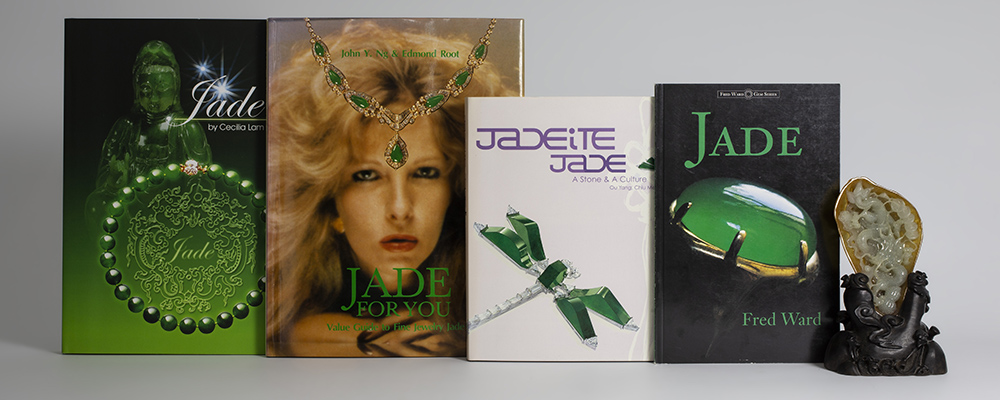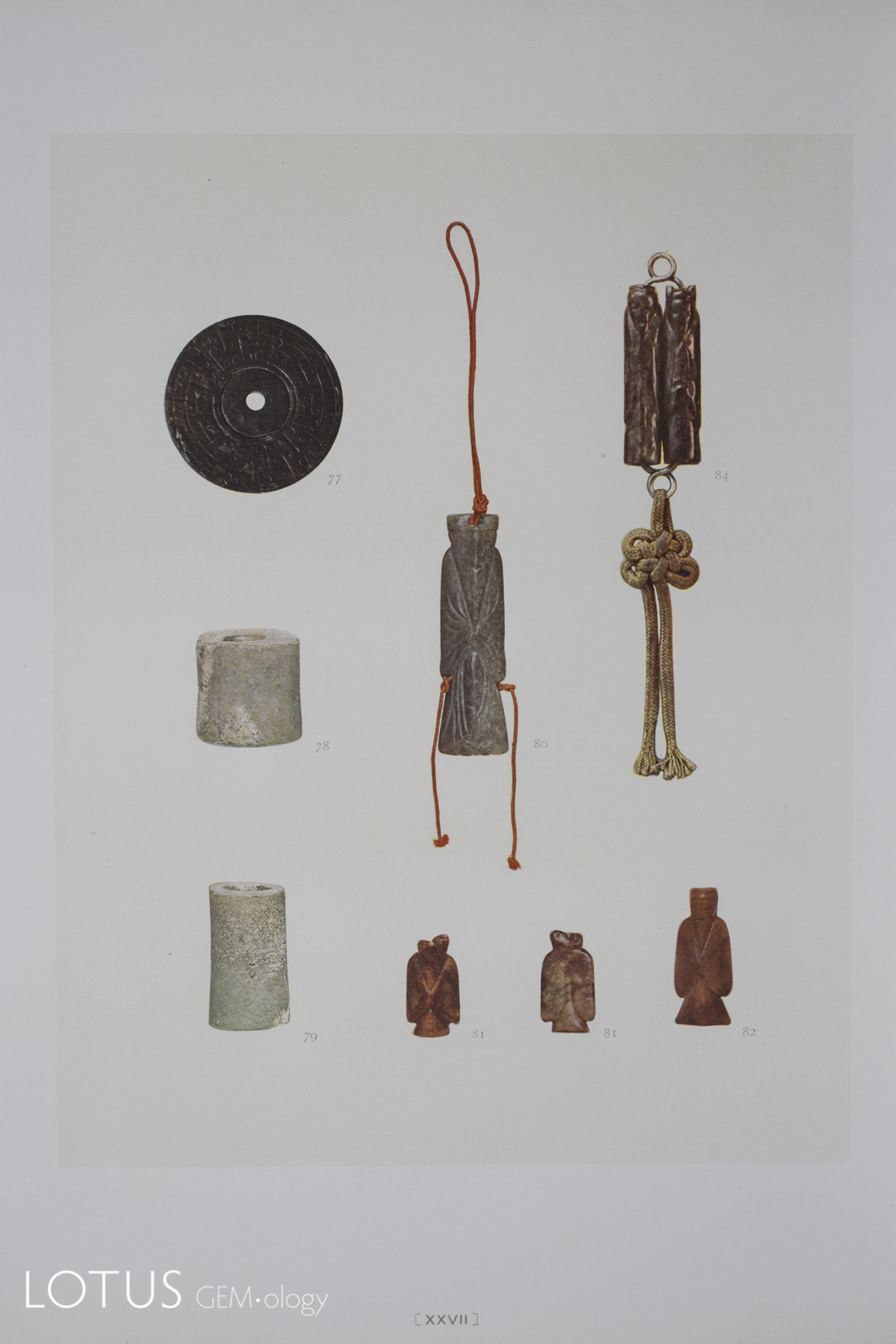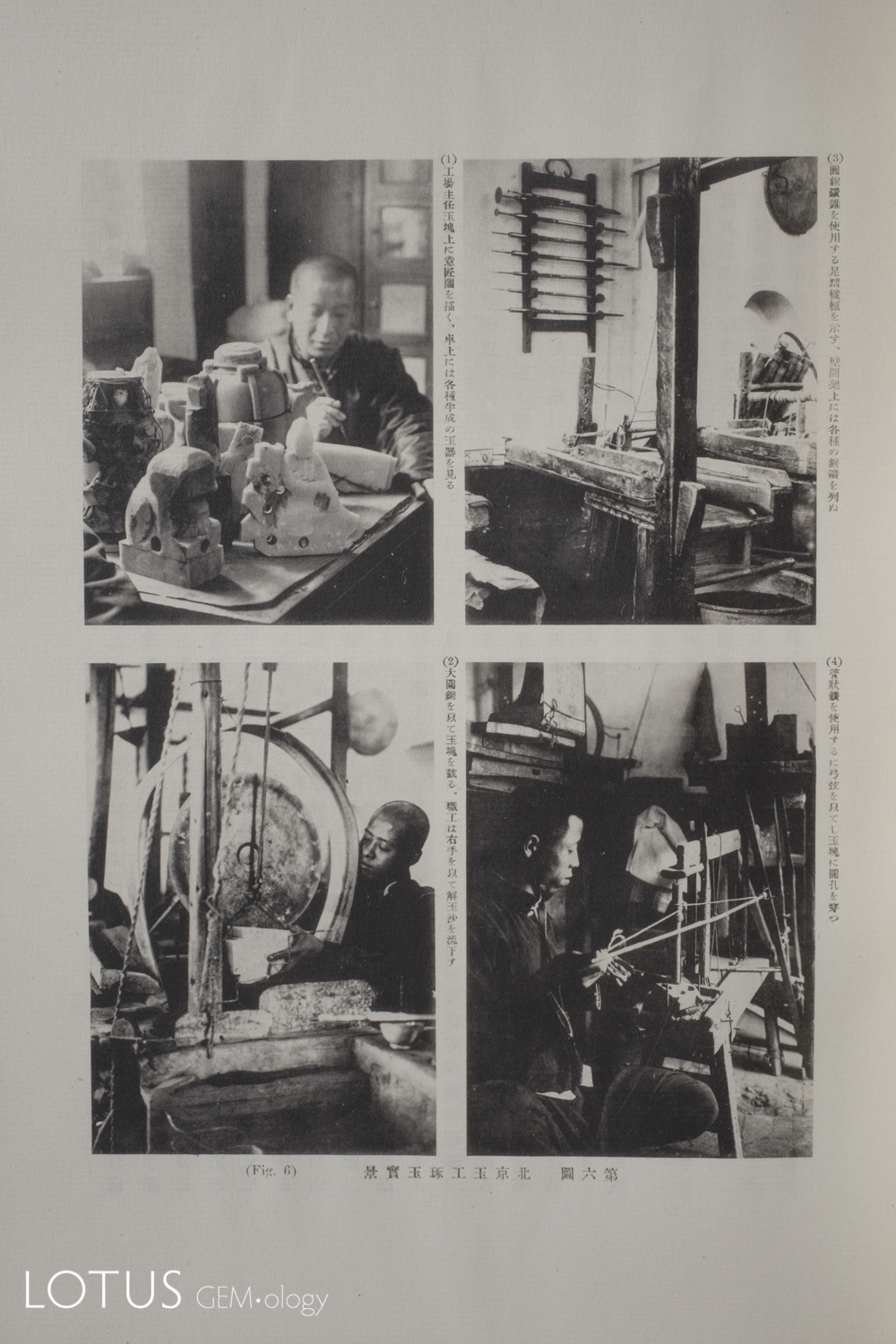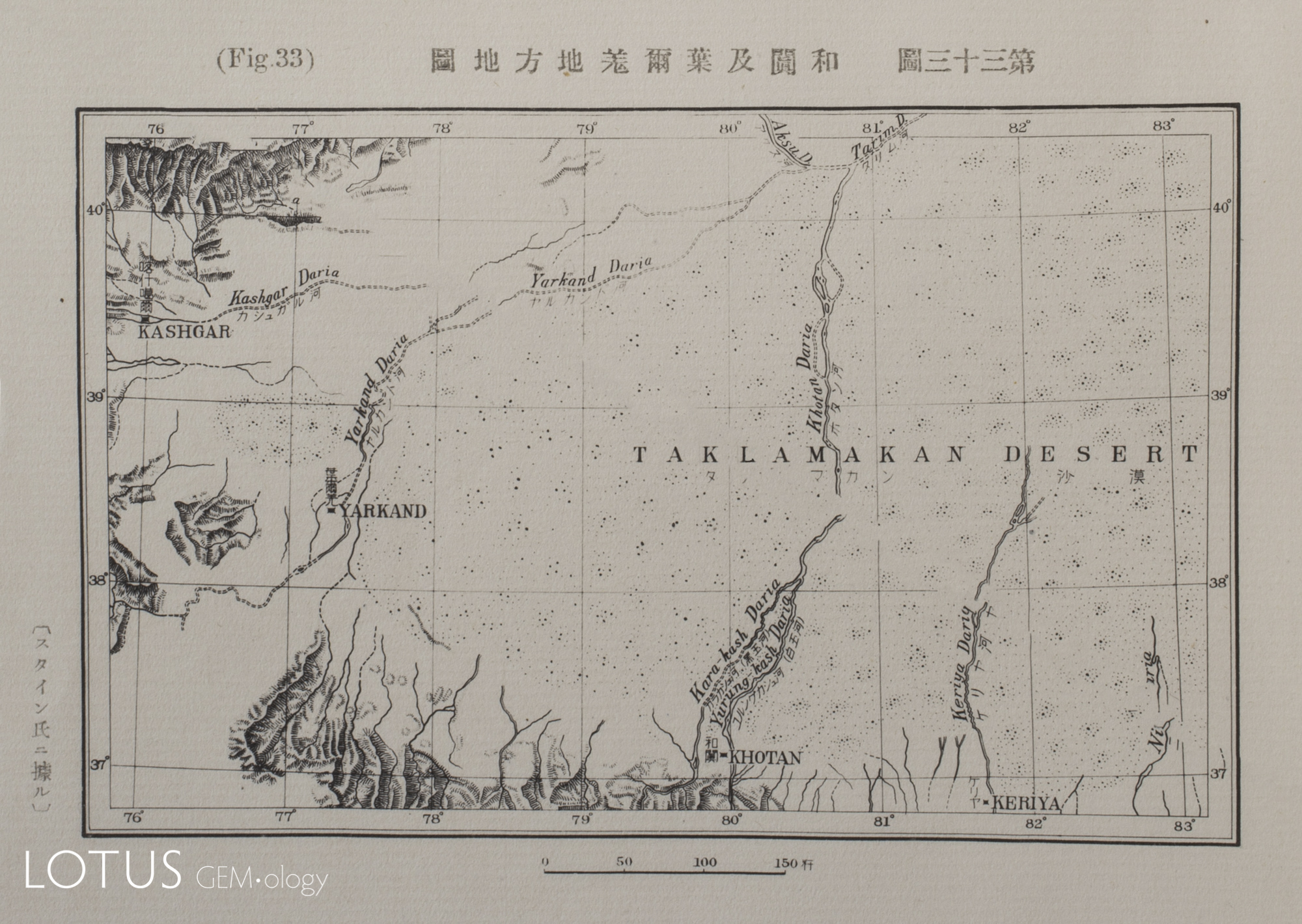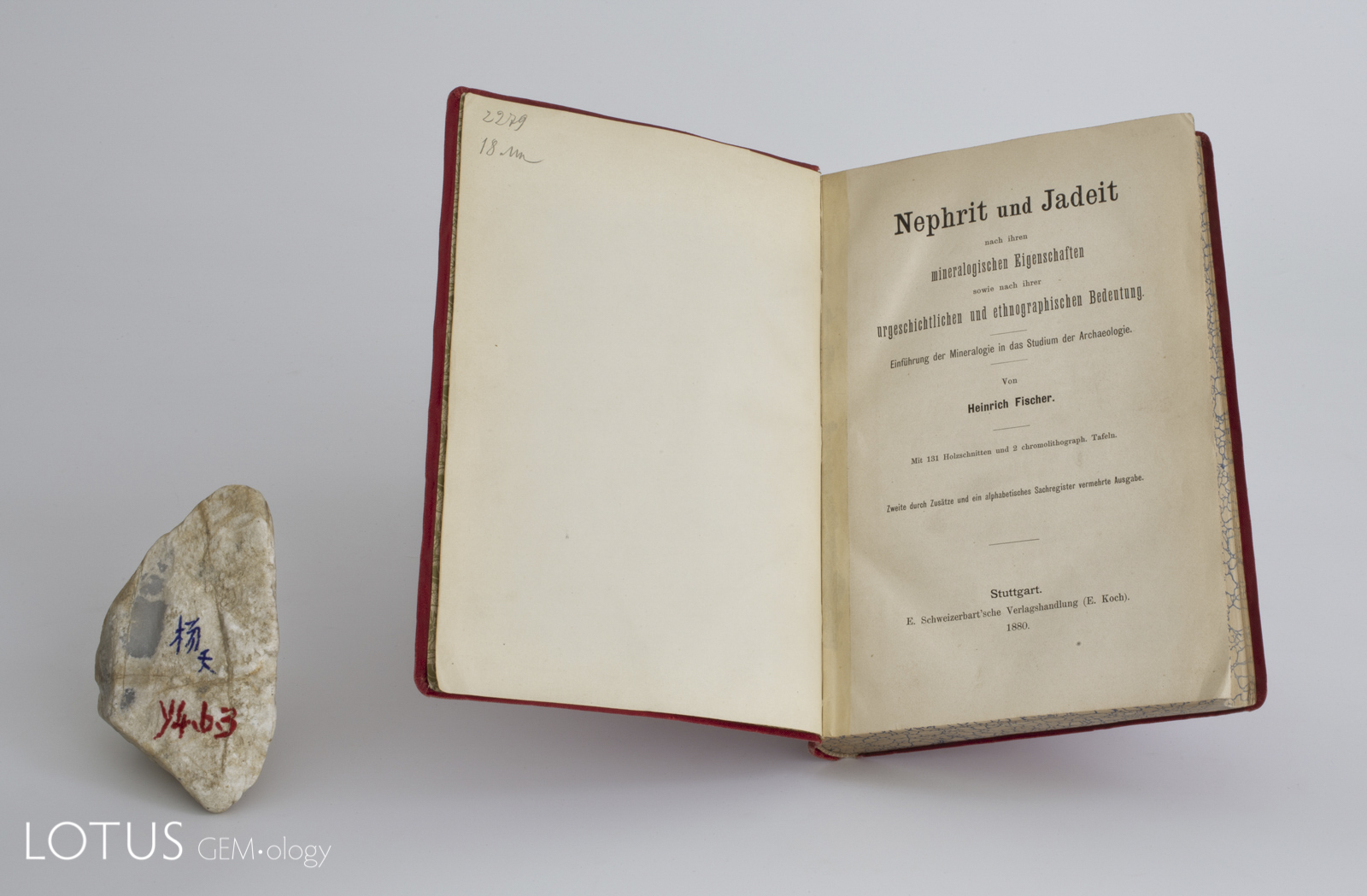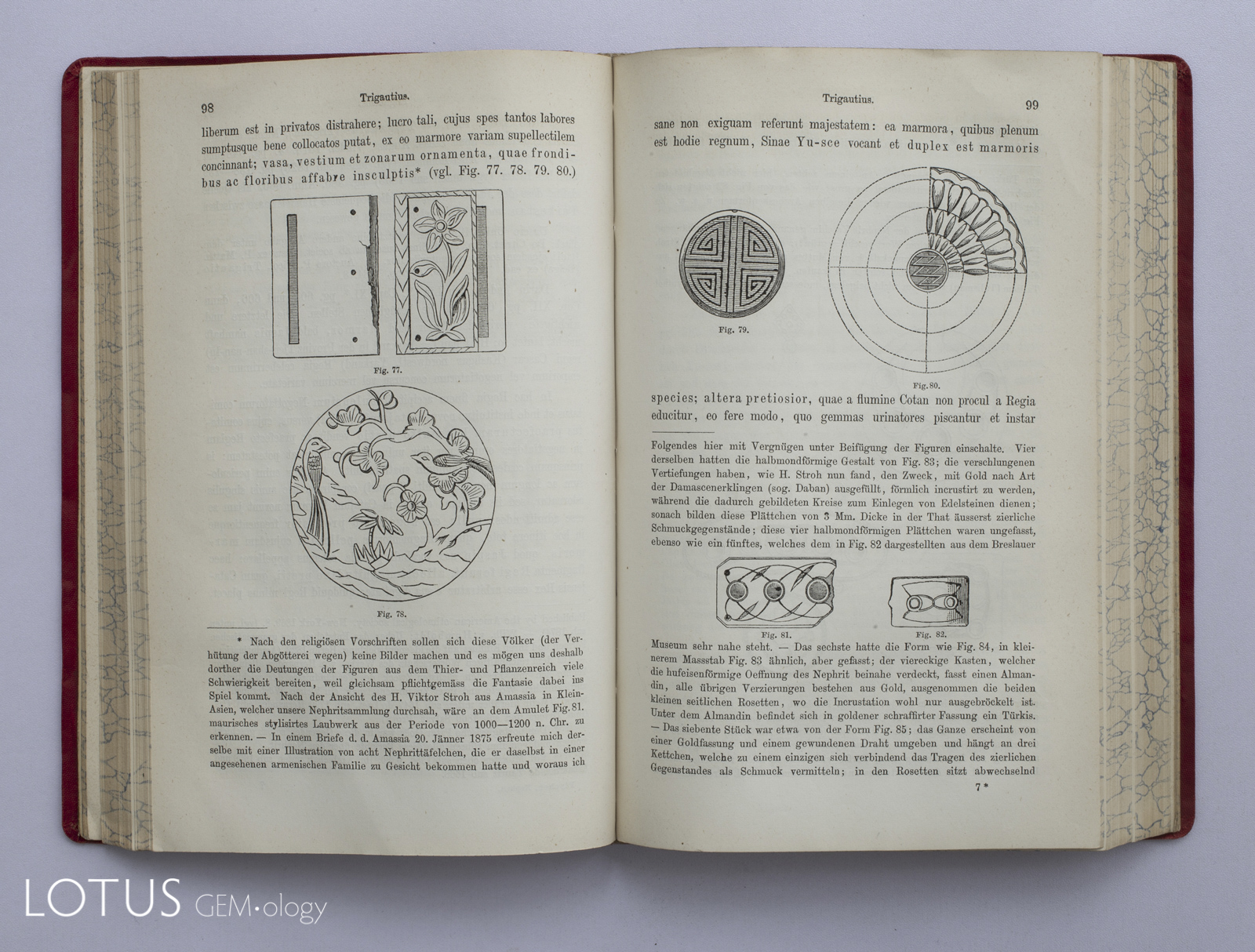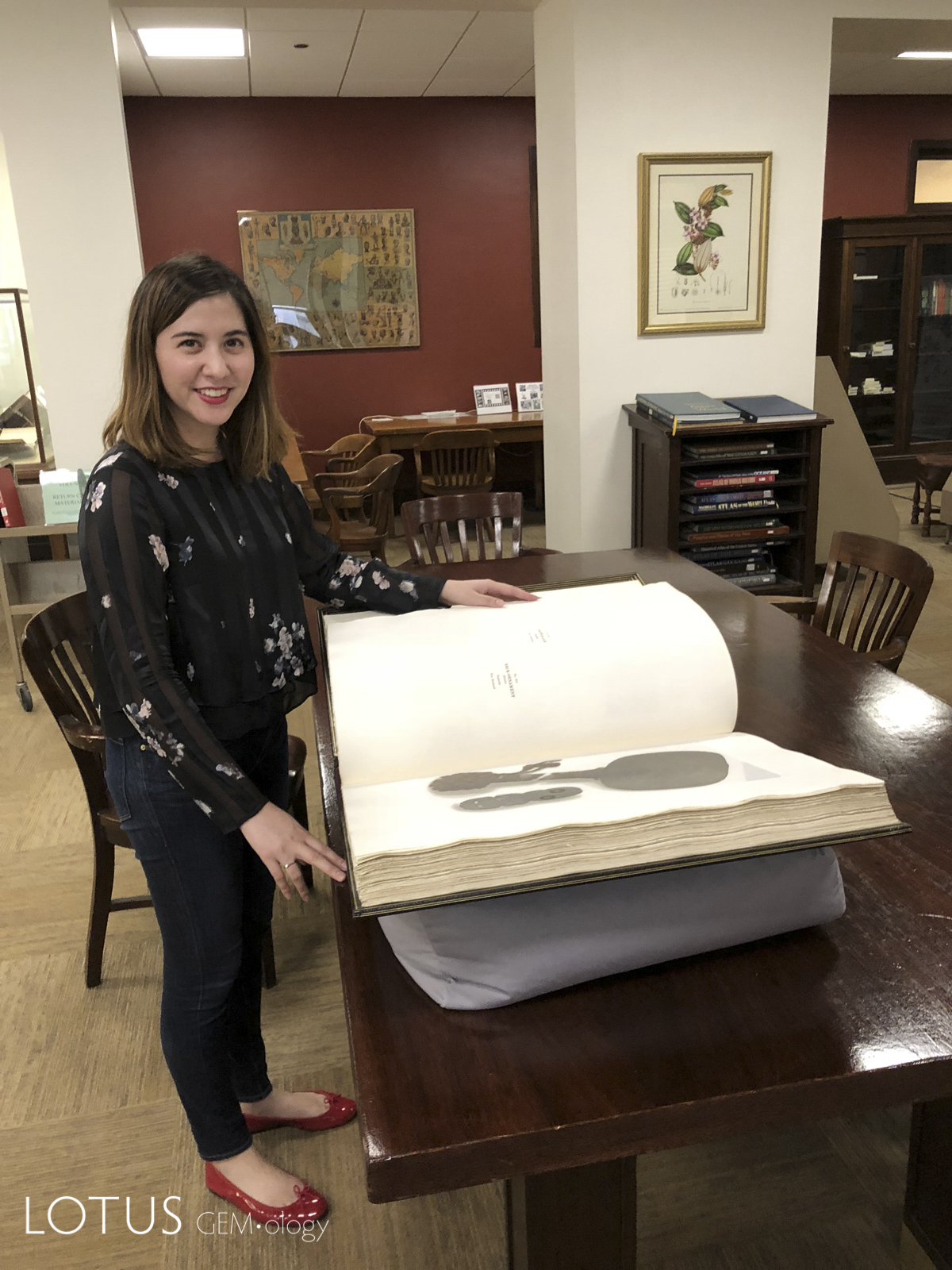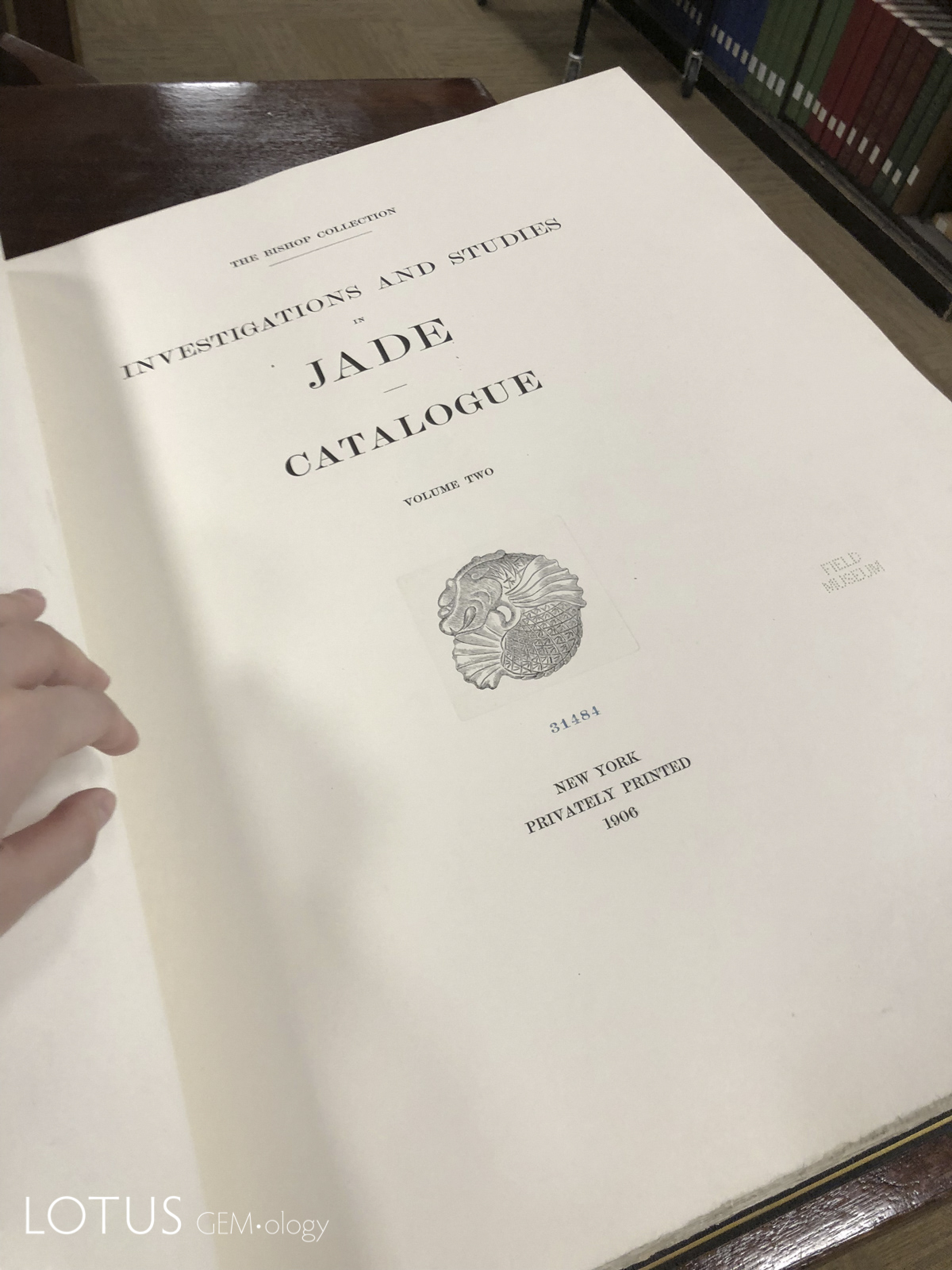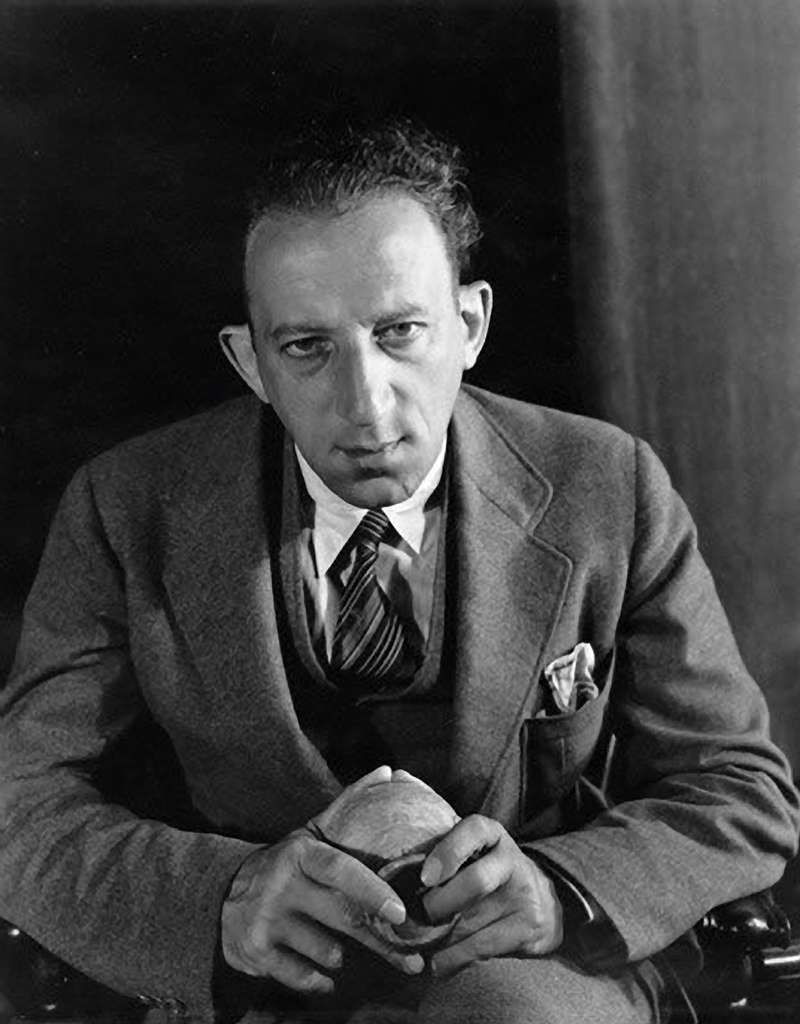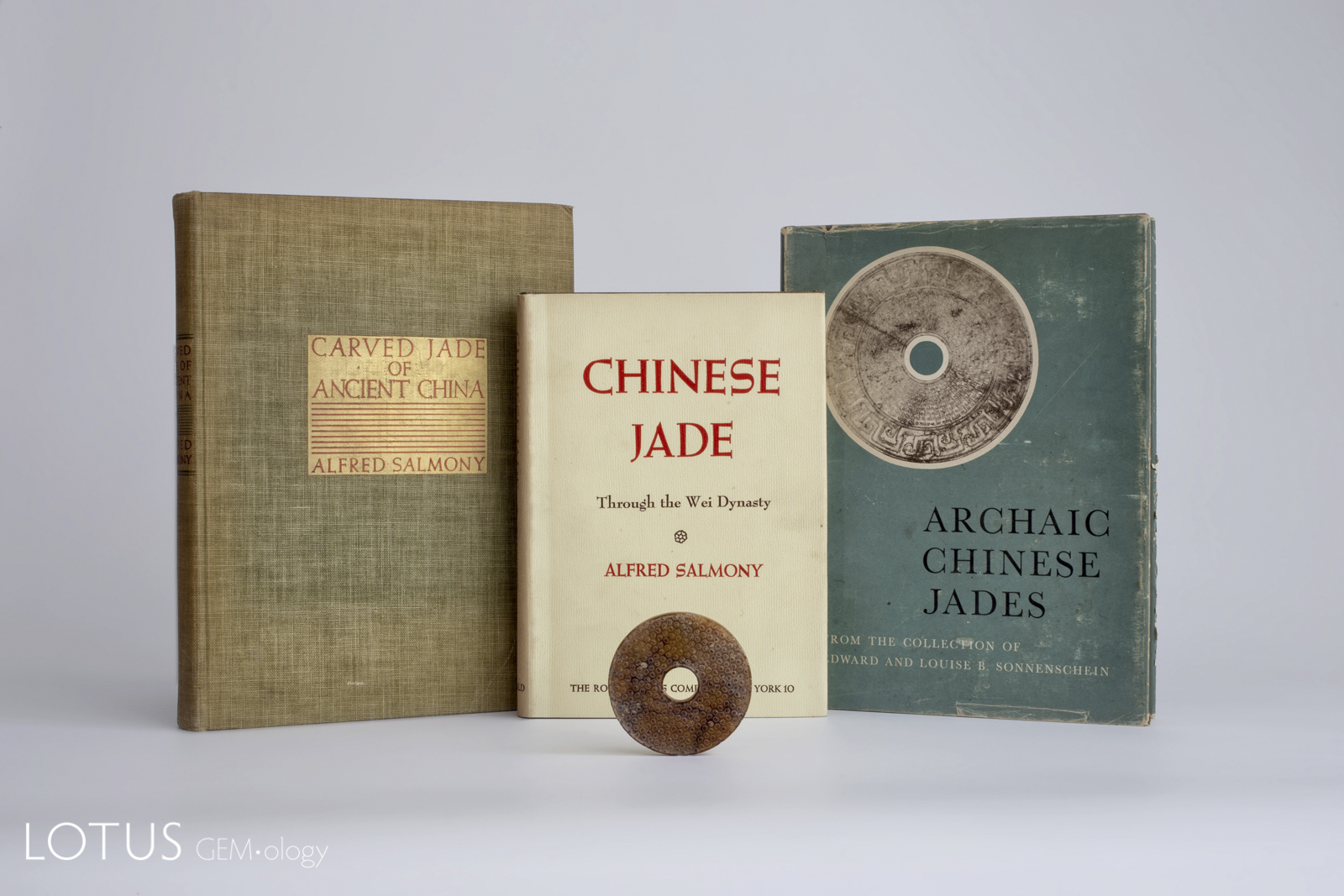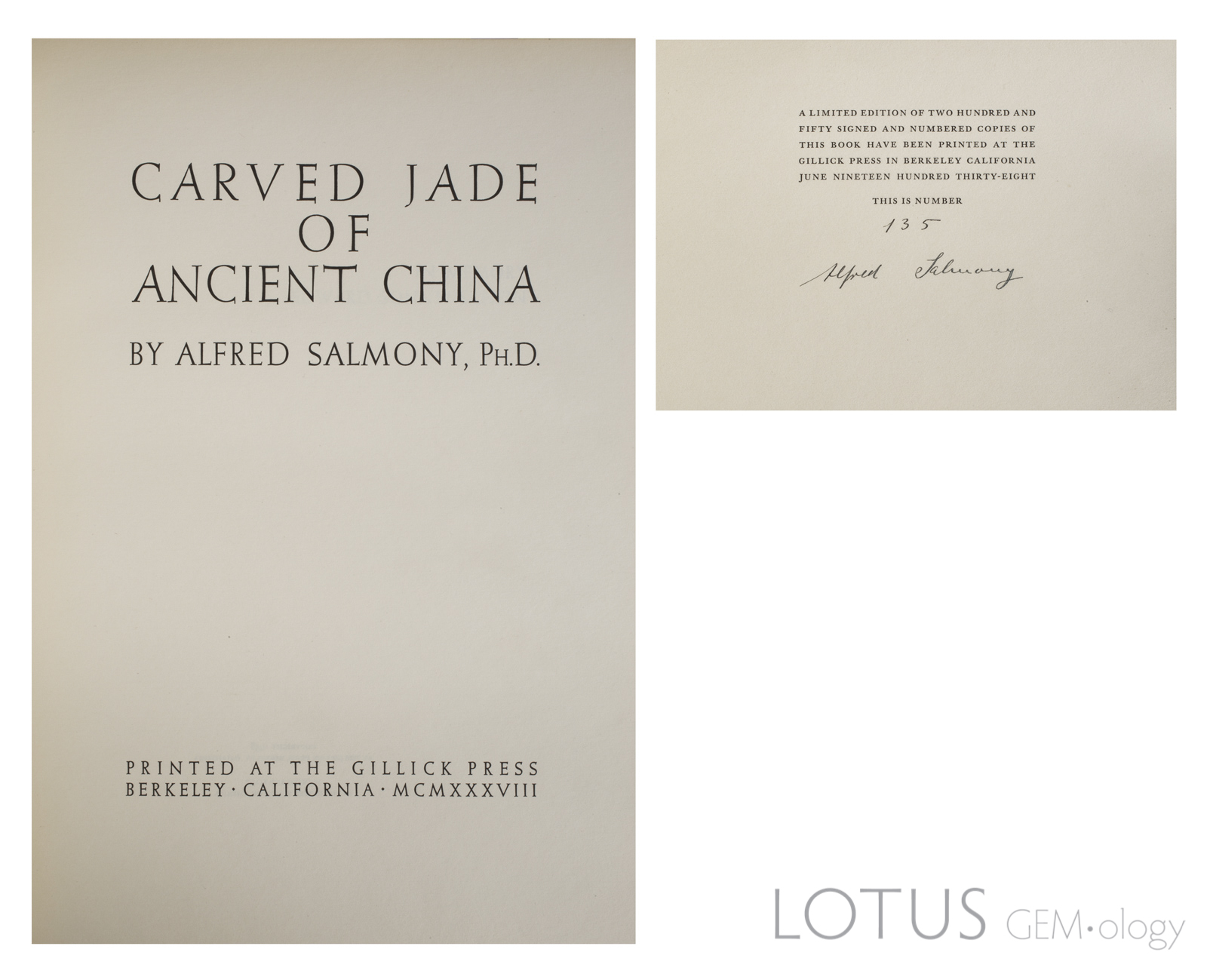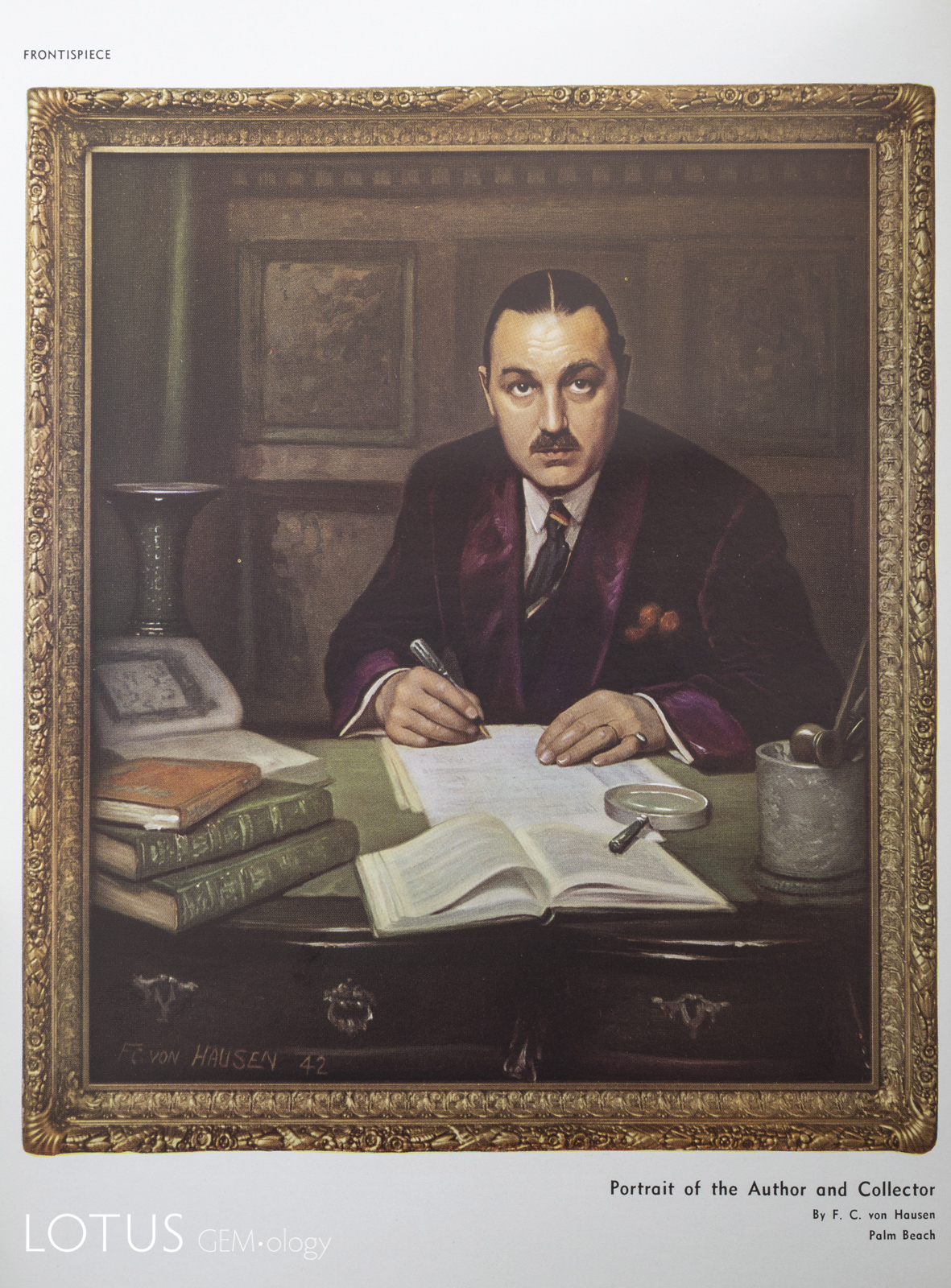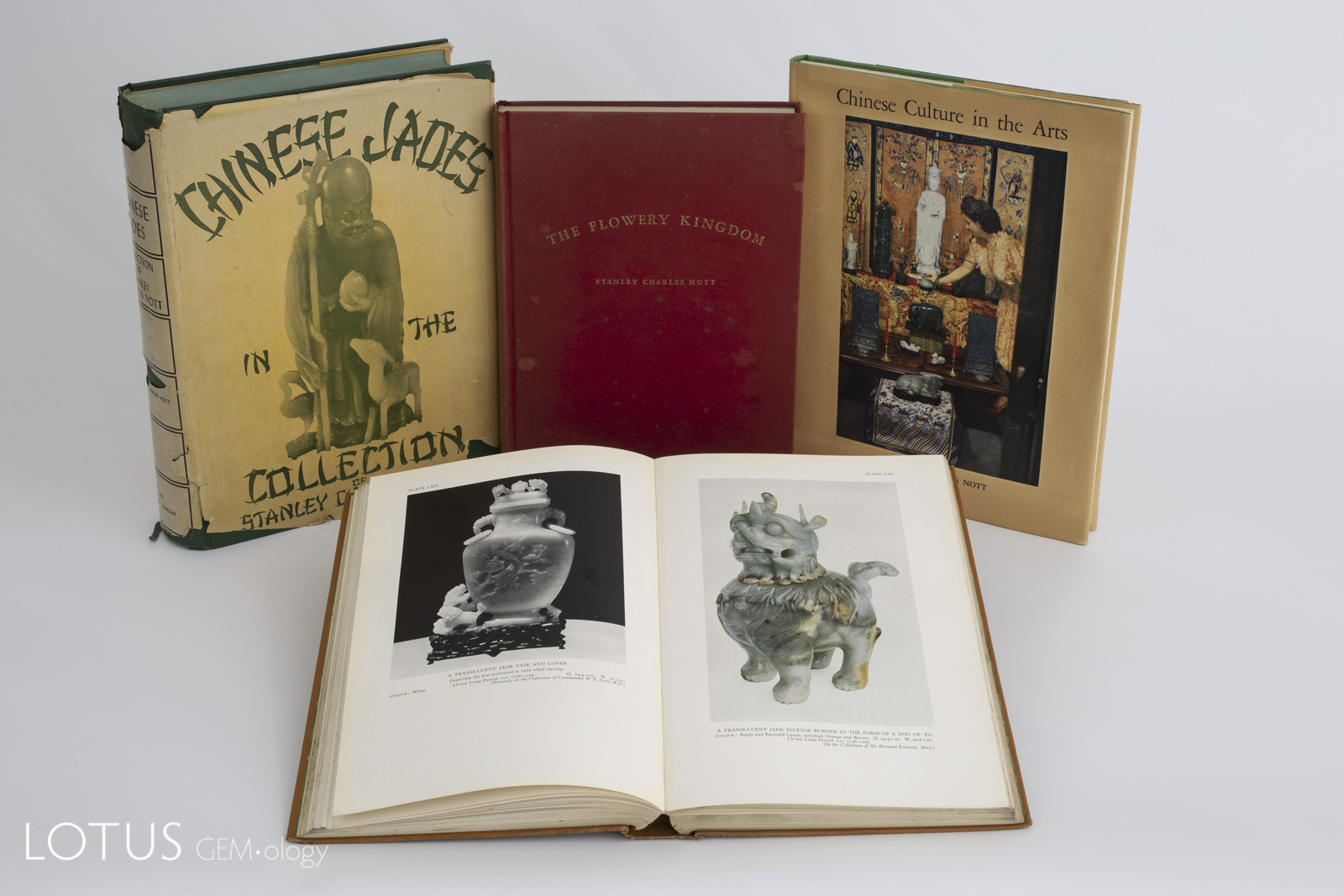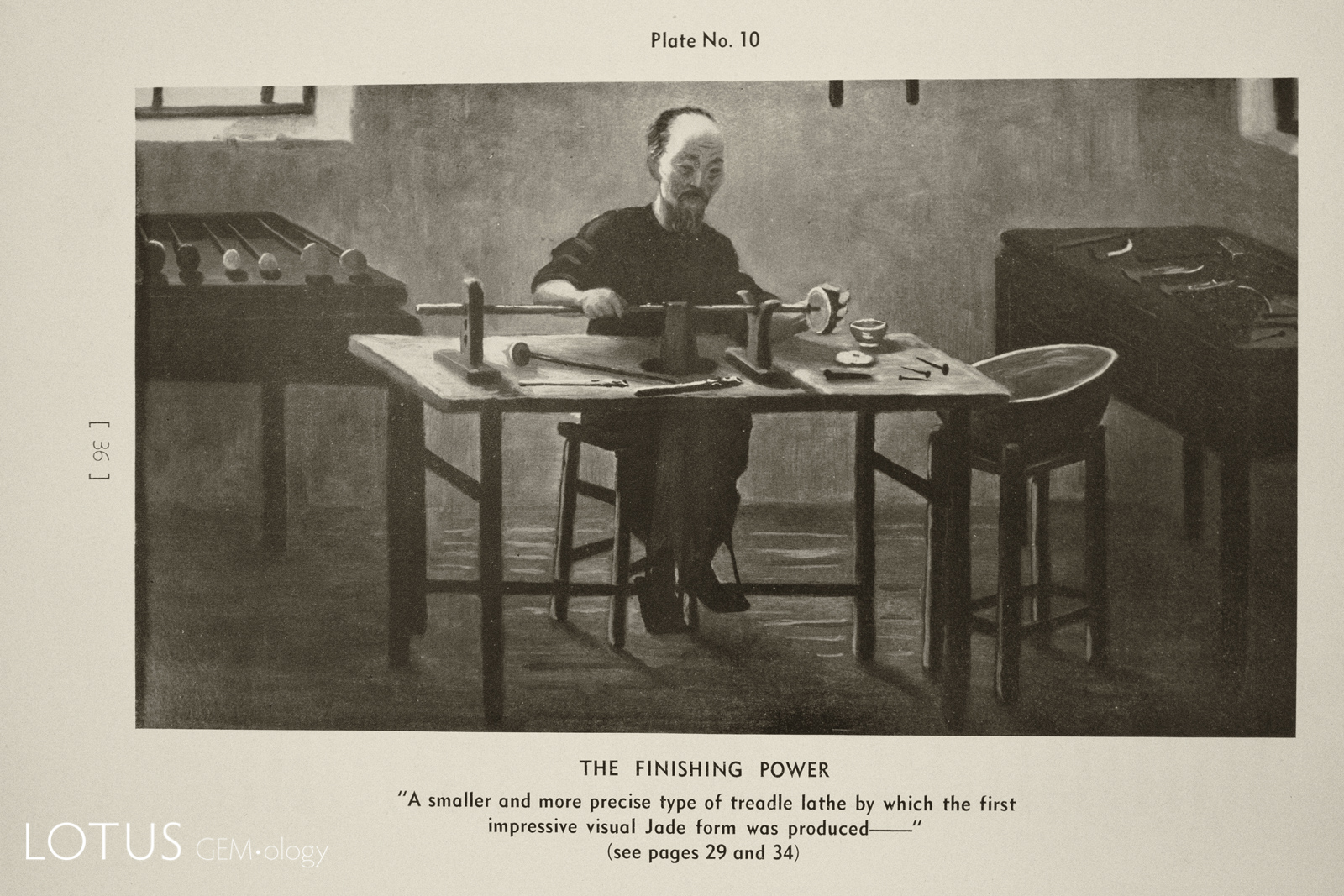A discussion of the literature of jade, with particular emphasis on the most collectable books covering both Chinese jade and jade around the world.
Introduction to jade and its importance in China
Jade has a history stretching back some 8000 years and, particularly in China, by virtue of its unique features, it has a place of influence unmatched by any other material or art form. As testimony to the importance of jade, there exist perhaps 2000 or more published books and papers on jade in Occidental languages, and that number probably quadruples if one includes works in Chinese. This literature encompasses a virtual history of human development and culture, and dwarfs that of other lapidary materials, including diamond. This article examines the (mostly) Occidental literature of jade from a collector’s point of view, highlighting the key works from the standpoints of rarity, utility, desirability, and value. Books of particular merit are highlighted as an aid to readers who wish to explore this fascinating aspect of human development.
Bibliographic works on jade
For those who aspire to collect books, a good bibliography is to the collector as a good map is to an explorer. Without it, one can easily become lost. Fortunately, jade book collectors have access to several first-class bibliographies. Top of the list is that of Gerald Born (1982), who produced a solid work. Bibliography is tedious work, and we are blessed by Born’s attention to detail.
Similarly, the gemological world counts itself lucky because of John and Marge Sinkankas. John was not only a prolific author, but together with his wife, Marge, operated “Peri Lithon,” devoted to the sale of second-hand books on gems and minerals. Their crowning achievement was a massive, annotated two-volume bibliography of gemology. This included dozens of items on jade. John Sinkankas also contributed the bibliography section of Roger Keverne’s Jade. For those who can read Chinese, we also have Yang’s and Zhao’s bibliographies, published in 1982 and 2004 respectively.
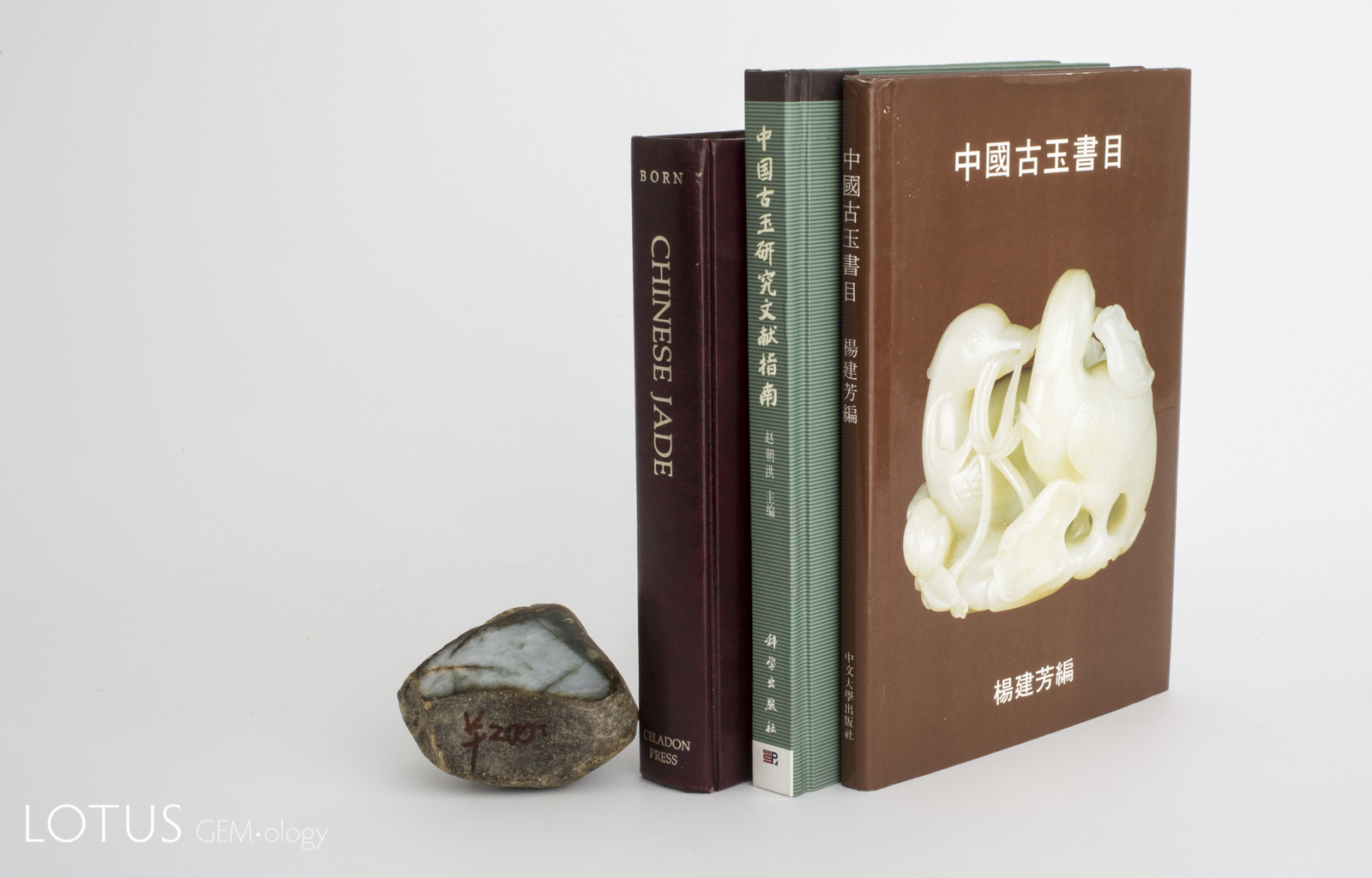 For the collector, bibliographies are essential references. From left to right: Born, Zhou and Yang. At left is a sliced piece of rough Burmese jadeite. Photo: Pinyo Khongsawad/Lotus Gemology Co. Ltd. Click on the photo for a larger image.
For the collector, bibliographies are essential references. From left to right: Born, Zhou and Yang. At left is a sliced piece of rough Burmese jadeite. Photo: Pinyo Khongsawad/Lotus Gemology Co. Ltd. Click on the photo for a larger image.
Select references
- Born, G.M. (1982) Chinese Jade: An Annotated Bibliography. Chicago: Celadon Press, 431 pp.
- Sinkankas, J. (1991) Bibliography of jade. In Jade, Keverne, R., ed., New York: Van Nostrand Reinhold, pp. 356–367.
- Sinkankas, J. (1993) Gemology: An Annotated Bibliography. Metuchen, NJ, The Scarecrow Press, Inc., 2 Vols., 1179 pp.
- Yang, J. (1982) Zhongguo Guyu Shumu [Bibliography of Ancient Chinese Jade]. [in Chinese and English], Hong Kong, Center for Chinese Archaeology Art, Institute on Chinese Culture, Chinese University of Hong Kong, 141 pp.
- Zhao, C. (2004) Zhongguo Guyu Yanjiu Wenxian Zhinan 中国古玉硏究文献指南 [A Guide to Research Literatures on Chinese Ancient Jades]. [in Chinese], Beijing: Kexue Chubanshe, 362 pp.
Important 19th and early 20th century Chinese & Japanese books on jade
Chang Huang-Chao was a Western-educated scientist who authored Shih Ya, Pao Shih Shuo: Lapidarium Sinicum, probably the first Chinese book on rocks and minerals from the standpoint of both Eastern and Western science. While not without its flaws, it contains much of interest, including material on jade. Copies of both the first and second editions are exceedingly scarce; thankfully it has been reprinted.
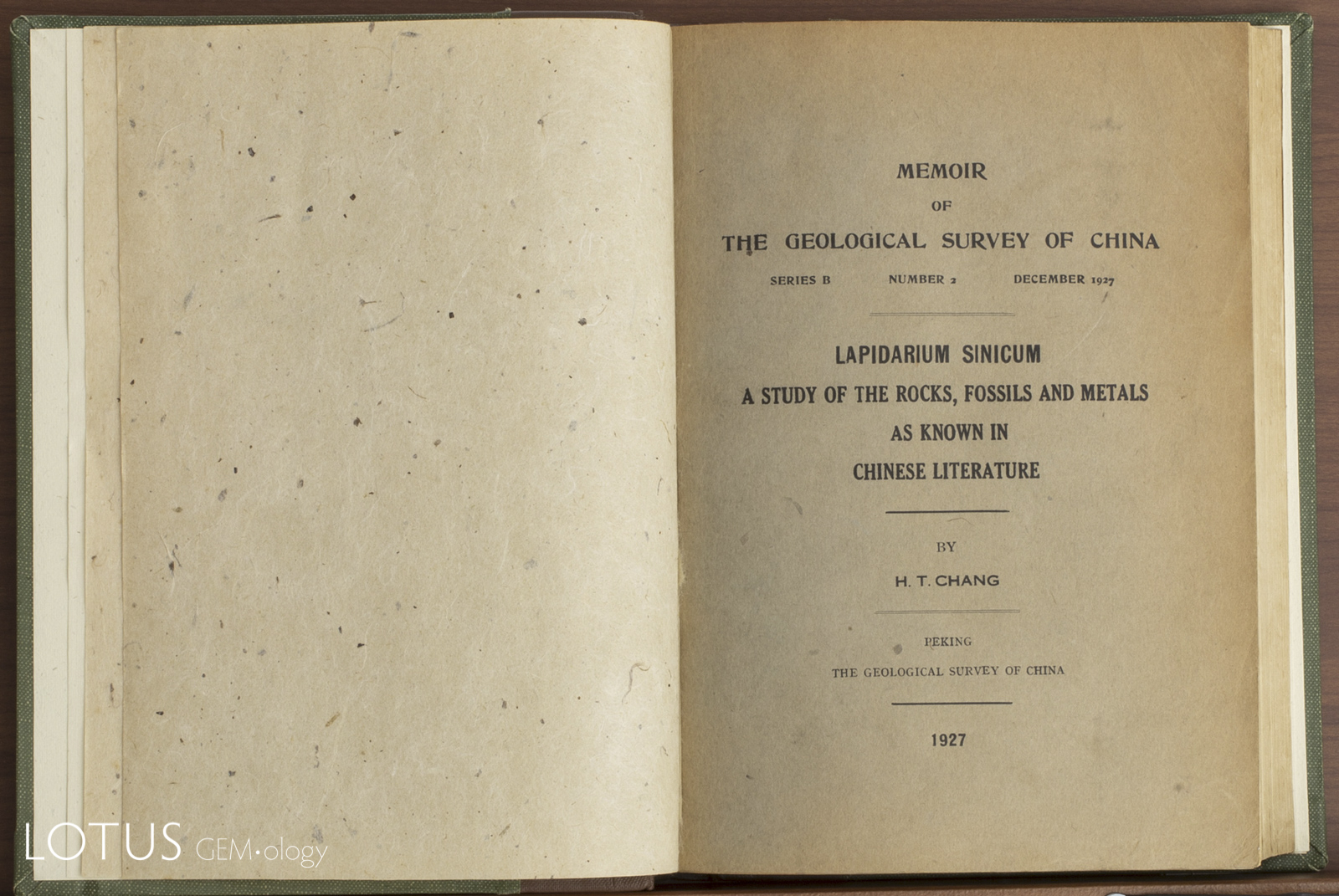 Title page of the 1927 edition of H.T. Chang's Lapidarium Sinicum. Today this book is exceedingly scarce. The text is in Chinese. Photo: Pinyo Khongsawad/Lotus Gemology Co. Ltd. Click on the photo for a larger image.
Title page of the 1927 edition of H.T. Chang's Lapidarium Sinicum. Today this book is exceedingly scarce. The text is in Chinese. Photo: Pinyo Khongsawad/Lotus Gemology Co. Ltd. Click on the photo for a larger image.
Kosaku Hamada’s Yuchikusaizo-Kogyokufu, or The Early Chinese Jades in the Collection of the Late Riichi Uyeno, is a lovely two-volume set bound in traditional Japanese style with a folding case featuring bone clasps. The first string-sewn volume treats important jade books, jade sources, “fishing” for jade at Khotan, lapidary methods, etc. The second is a slipcased set of tissue-guarded plates of archaic jades from Riichi Uyeno’s collection. This is one of the rarest and most collectible of all jade books.
![Kosaku Hamada’s 1936 有竹斎蔵古玉譜 [Yuchikusaizo-Kogyokufu, or The Early Chinese Jades in the Collection of the Late Riichi Uyeno]. The two volumes were housed in a traditional Japanese case, making this particularly collectable.](/images/library/articles/book-reviews/Jade-Books/Hamada-1936.jpg) Kosaku Hamada’s 1936 有竹斎蔵古玉譜 [Yuchikusaizo-Kogyokufu, or The Early Chinese Jades in the Collection of the Late Riichi Uyeno]. The two volumes were housed in a traditional Japanese case, making this particularly collectable. Photo: Pinyo Khongsawad/Lotus Gemology Co. Ltd. Click on the photo for a larger image.
Kosaku Hamada’s 1936 有竹斎蔵古玉譜 [Yuchikusaizo-Kogyokufu, or The Early Chinese Jades in the Collection of the Late Riichi Uyeno]. The two volumes were housed in a traditional Japanese case, making this particularly collectable. Photo: Pinyo Khongsawad/Lotus Gemology Co. Ltd. Click on the photo for a larger image.
Chinese statesman, scholar, and connoisseur Wu Dacheng (Wu Ta-Ch’eng; 1835–1902) collected a wide variety of Chinese antiquities, but most especially jades. Wu was among the first to deduce the use and meaning of many of the ancient jades being unearthed in China. He gave the first plausible explanations for such ritual jades as the cong, huang, and xuanji. Wu published his findings in his famous book Guyu Tukao (Ku yü t'u k'ao) in 1889. Originally two volumes, it illustrates 245 jades in woodcuts done by his brother. It was later reprinted in four volumes and then again (in Taipei) in 1971. Laufer (q.v.) relied heavily—perhaps too heavily—on Wu’s writings and reproduced in his book 95 of Wu’s illustrations.
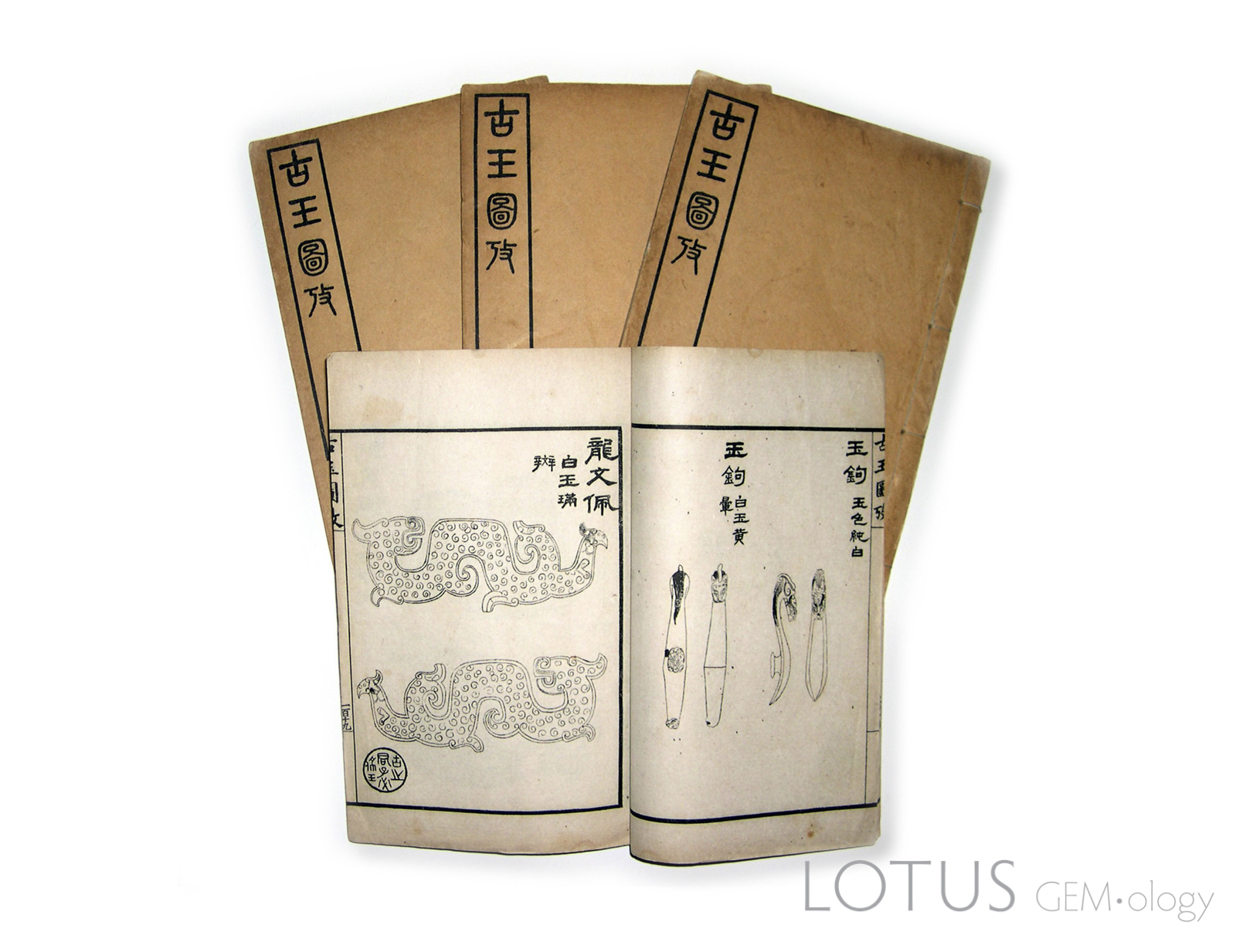 Wu Dacheng's 1889 book on jade, Guyu Tukao (Ku yü t'u k'ao). Photo: Eric Hoffman. Click on the photo for a larger image.
Wu Dacheng's 1889 book on jade, Guyu Tukao (Ku yü t'u k'ao). Photo: Eric Hoffman. Click on the photo for a larger image.
Select references
- Chang, H.-C. (1921) Shih Ya, Pao Shih Shuo: Lapidarium Sinicum: A study of the rocks, minerals, fossils and metals as known in Chinese literature. [in Chinese], Peking, Geological Survey of China Memoirs, Series B, No. 2, May, ix, 348 pp., 2nd ed. 1927, Series B, No. 2, December, 432 pp.
- Demiéville, P. (1924) Review: Che ya 石雅. (Lapidarium sinicum. A Study of the Rocks, Minerals, Fossils and Metals as Known in Chinese Literature) by Tchang Hong-tchao and 章滴剑. Bulletin de l'École française d'Extrême-Orient, Vol. 24, No. 1/2, pp. 276–301.
- Hamada, Kosaku [濱田耕作] (1936) 有竹斎蔵古玉譜 [Yuchikusaizo-Kogyokufu, or The Early Chinese Jades in the Collection of the Late Riichi Uyeno]. [in Japanese], Tokyo: 2 Vols., 30 leaves, 12 plates.
- Wu Ta-Ch’eng (1889) 古玉圖考 [Gu-yü T'u-k'ao–Investigations into Ancient Jades with Illustrations]. [in Chinese], Shanghai: Ch’ing Kuang-hsu, 4 vols. stitched in traditional Chinese style, woodblock printed Chinese text, 78 + 80 + 78 + 70 pp; reprinted 1971 by Wu Ch'ing-ch'ing; Taipei; 8 pp + 144 leaves, illus, 22 cm.
19th century Occidental books on jade
It is stunning to think that such an important topic as Chinese jade could have entirely escaped scientific study in Europe until the 19th century. But it was only the appearance of Jean-Pierre Abel-Rémusat’s Histoire de la ville de Khotan in 1820 that European science was trained on jade. Abel-Rémusat (1788–1832) was schooled in medicine, but became fascinated with the Chinese language after happening upon a Chinese herbal treatise. Teaching himself Chinese, he later authored a number of papers and books on the Chinese language and literature. His Histoire de la ville de Khotan contains the first detailed study of the Chinese yü (玉, jade) to appear in a European language, including the etymology and chemical analysis. Original copies of this book are exceedingly rare. Fortunately, the section on jade was translated into English by the Friends of Jade in 1980. Interestingly enough, while much of Abel-Rémusat’s career was spent on things Chinese, he never actually visited China.
In 1846, French chemist Alexis Damour did the first chemical analysis of nephrite, finding it to be an amphibole (Damour, 1846). Later, following the 1860 sacking of Beijing’s Summer Palace by British and French armies, where many Chinese jade objects were stolen and then made their way to Europe, Damour again analyzed jade. He found the vivid green stones to be chemically different from the white-to-pale green nephrite jade and named the new stone "jadeite" (Damour, 1863).
The next major monograph on jade came not from France, but from Germany. In 1875, Leopold Heinrich Fischer (1817–1886) published an extraordinary work on jade, Nephrite un Jadeit, by far the most comprehensive ever to appear. Fischer examined jade not just from China, but from around the world. The 1875 edition is so scarce that even John Sinkankas never saw a copy, while the 1880 edition is equally rare. Sinkankas put it best when he said: “All future students of jade, especially of jade in antiquity, must forever be grateful to Fischer…”
Left: Title page from the 1880 edition H. Fischer's Nephrit und Jadeit. Initially published in 1875, it was the first monograph in an Occidental language to be solely devoted to jade. At left is a piece of rough Burmese "ice" jadeite, with a small window polished through the skin.
Right: A spread from H. Fischer's Nephrit und Jadeit. Photos: Pinyo Khongsawad/Lotus Gemology Co. Ltd. Click on the photos for larger images.
Select references
- Abel-Rémusat, J.P. (1820) Histoire de la ville de Khotan, tirée des annales de la chine et traduite du chinois; Suivie de Recherches sur la substance minérale appelée par les Chinois pierre de Iu, et sur le Jaspe des anciens. Paris: L’Imprimerie de Doublet, 239 pp. Jade portion translated into English in Vol. 1 of The Bulletin of the Friends of Jade, 1980, pp. 1–50.
- Damour, A. (1846) Analyse du jade oriental, réunion de cette substance à la trémolite. [trans. into English by Herbert Giess in The Bulletin of the Friends of Jade, 1994, Vol. 8, pp. 47–50], Annales de Chimie et Physica, Series 3, Vol. 16, pp. 469–474.
- Damour, A. (1863) Notice et analyse sur le jade vert: réunion de cette matière minérale à la famille des wernerites. Comptes Rendus des Séances de l’Académie des Sciences, Vol. 56, Janvier–Juin, pp. 861–865.
- Fischer, H. (1875) Nephrit und Jadeit. Stuttgart: E. Schweizerbart'sche Verlagshandlung (E. Koch), 1st ed. (2nd ed. 1880), 409 pp.
Early 20th century works
Berthold Laufer (1874–1934) was an anthropologist with expertise in East Asian cultures. When he joined Chicago’s Field Museum in 1908 he was one of the few scholars in America who could speak and write Chinese fluently. He authored a prodigious number of publications covering a vast array of Chinese and related topics. But his book of most interest to jade aficionados is Jade: A Study in Chinese Archaeology and Religion (1912). The Introduction alone provides a fascinating review of the early Chinese literature of jade, both authentic and spurious. Then follows a detailed exploration of every type of Chinese jade carving, beginning with the most primitive axes and tools and moving on to ritual items, seals, personal adornments, burial jades, vessels, and much more.
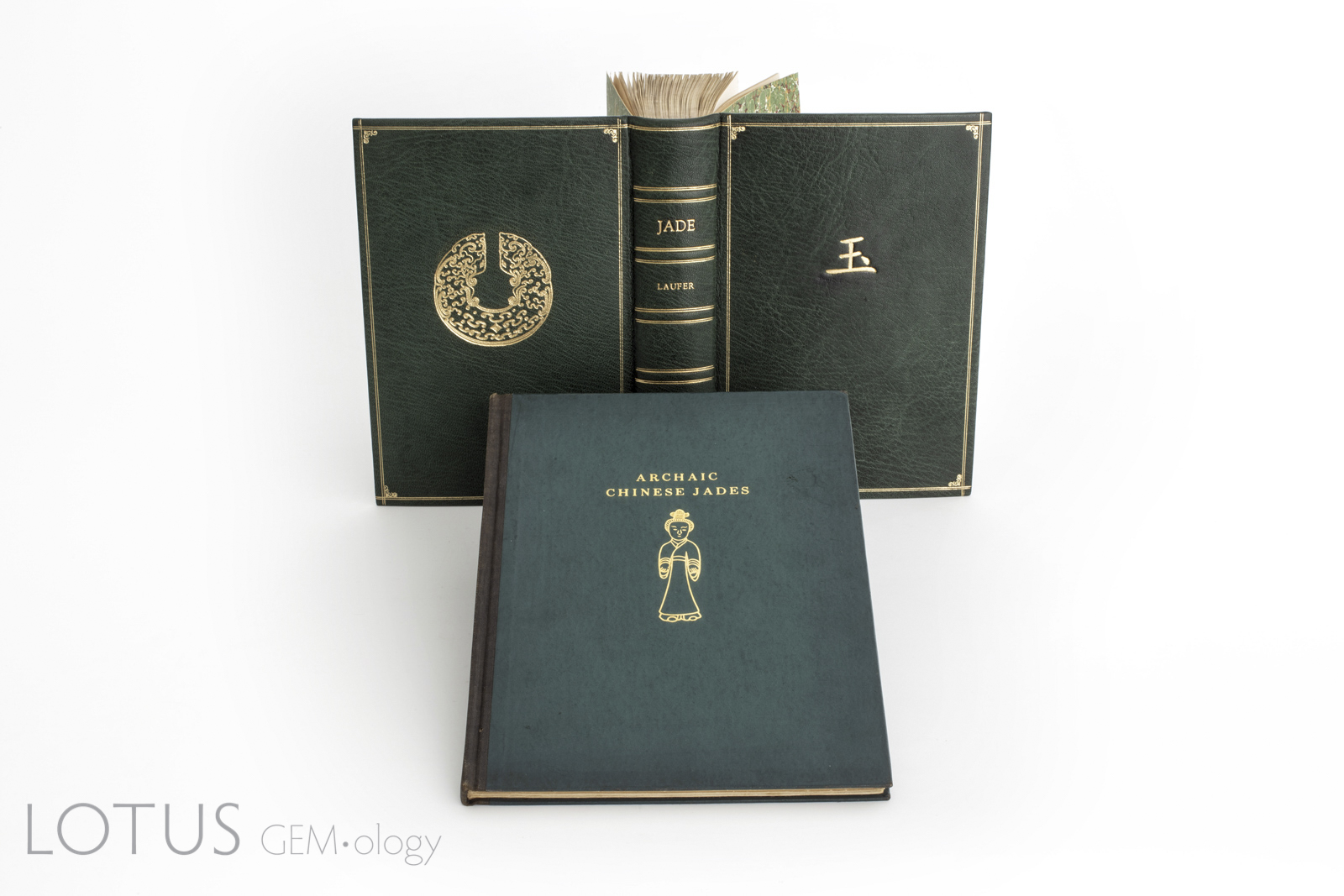 Berthold Laufer's two major works on jade. The top book, Jade: A Study in Chinese Archaeology and Religion, was originally issued in a rather pedestrian buckram binding. Author Richard Hughes had his copy rebound by Green Dragon Bindery in Massachusetts. The custom green Moroccan goatskin binding features designs from the book. Such a fine binding is literally one-of-a-kind, making the book even more valuable. Below it is a copy of Laufer's Archaic Chinese Jades Collected in China by A.W. Bahr. Photo: Pinyo Khongsawad/Lotus Gemology Co. Ltd. Click on the photos for larger images.
Berthold Laufer's two major works on jade. The top book, Jade: A Study in Chinese Archaeology and Religion, was originally issued in a rather pedestrian buckram binding. Author Richard Hughes had his copy rebound by Green Dragon Bindery in Massachusetts. The custom green Moroccan goatskin binding features designs from the book. Such a fine binding is literally one-of-a-kind, making the book even more valuable. Below it is a copy of Laufer's Archaic Chinese Jades Collected in China by A.W. Bahr. Photo: Pinyo Khongsawad/Lotus Gemology Co. Ltd. Click on the photos for larger images.
Laufer relied heavily on Wu’s Guyu Tukao (q.v.), sometimes at his peril. And modern jade scholarship has overtaken many of Laufer’s findings. Nevertheless, every student of jade should own and study this groundbreaking book. It was reprinted in 1946 and then in an easy to find soft-cover edition by Dover in 1974. Harder to find is Laufer’s Archaic Chinese Jades, Collected in China by A. W. Bahr (1927). The Englishman Bahr was able to purchase archaic jades from Wu Dacheng’s collection via Wu’s son-in-law. Bahr also acquired newly excavated pieces from the Zhou site, Xinzheng. Laufer purchased Bahr’s collection of 656 jades in 1927 for the Field Museum, for $100,000. Bahr’s jades were also prominent in the Arden Gallery show of 1939.
P. de Tanner, once Commissioner of the Chinese Maritime Customs Service, assembled a wonderful collection of jades early in the 20th century, illustrating the breadth and depth of Chinese jade carving. These are the subject of his two-volume set, Chinese Jade: Ancient and Modern (1925). One of the most difficult jade books to find, it is thus also one of the most collectible.
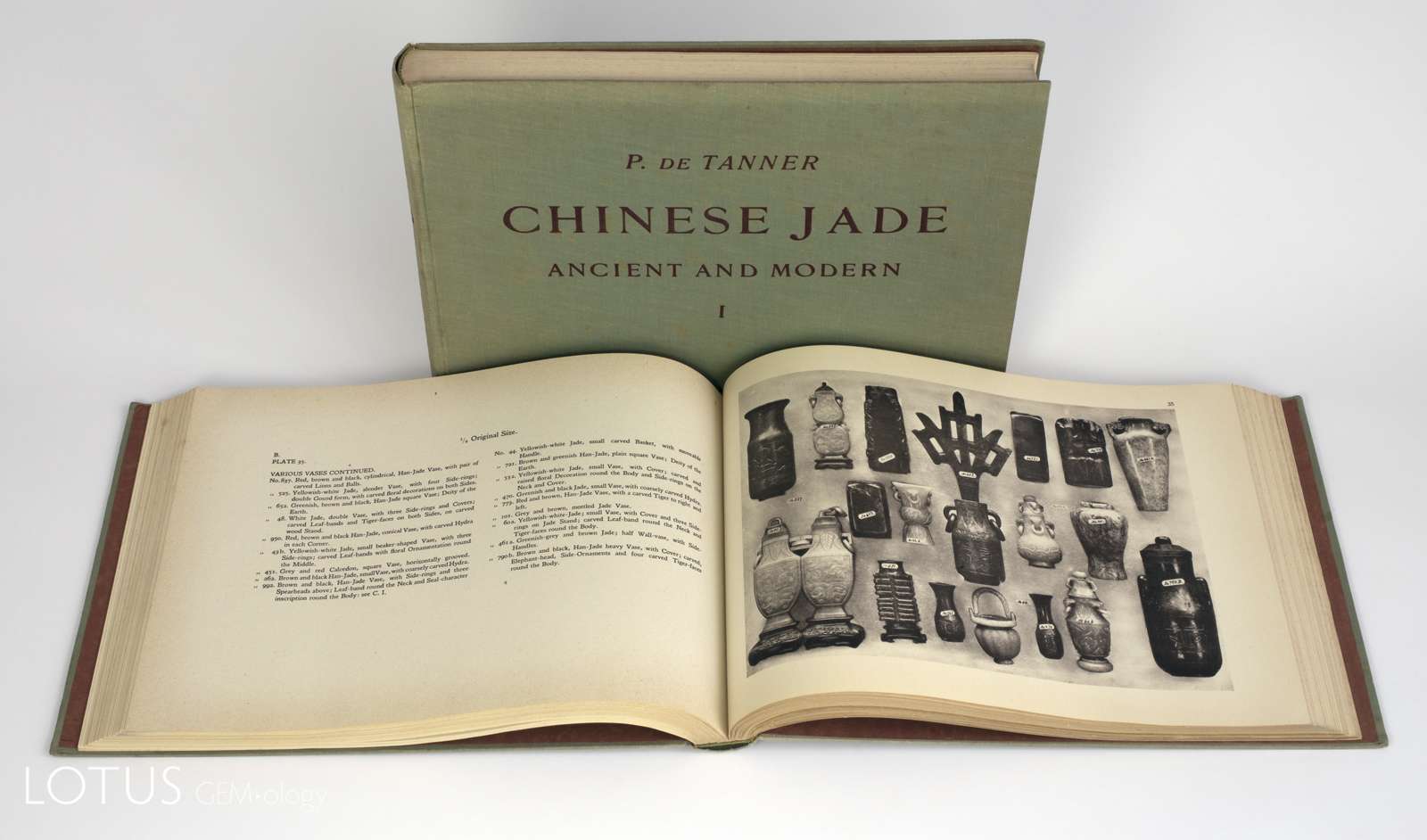 The two-volume 1925 de Tanner set, Chinese Jade: Ancient and Modern, is one of the most collectable books on jade. Photo: Pinyo Khongsawad/Lotus Gemology Co. Ltd. Click on the photo for a larger image.
The two-volume 1925 de Tanner set, Chinese Jade: Ancient and Modern, is one of the most collectable books on jade. Photo: Pinyo Khongsawad/Lotus Gemology Co. Ltd. Click on the photo for a larger image.
Una Constance Pope-Hennessy (1875–1949), who often published under the name of Una Birch, authored two books on jade. The first, 1923’s Early Chinese Jades, was one of the earliest English jade monographs. It appeared in two editions, with the leather-bound limited edition of only sixty copies being particularly scarce.
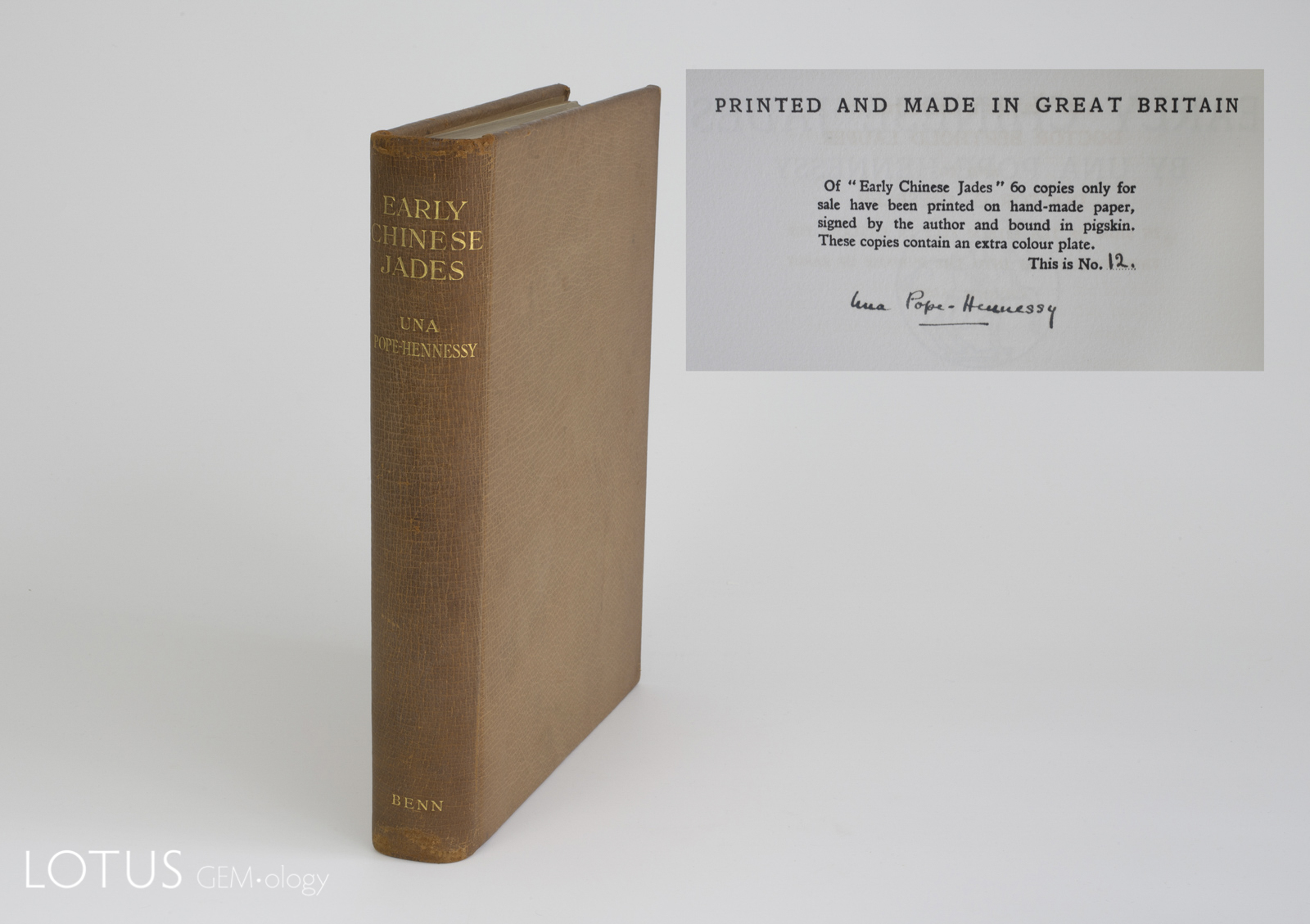 Una Pope Hennessy's Early Chinese Jades. This is the special limited edition, bound in pigskin. Inset: The limited-edition page of Una Pope Hennessy's Early Chinese Jades. Limited editions are highly collectable, and may fetch anywhere from two to five times more than the standard editions. Photo: Pinyo Khongsawad/Lotus Gemology Co. Ltd. Click on the photo for a larger image.
Una Pope Hennessy's Early Chinese Jades. This is the special limited edition, bound in pigskin. Inset: The limited-edition page of Una Pope Hennessy's Early Chinese Jades. Limited editions are highly collectable, and may fetch anywhere from two to five times more than the standard editions. Photo: Pinyo Khongsawad/Lotus Gemology Co. Ltd. Click on the photo for a larger image.
Select references
- Laufer, B. (1912) Jade: A Study in Chinese Archaeology and Religion. Chicago: Field Museum of Natural History, Publication 154, Anthropological Series, Vol. X, 2nd ed. reprinted by Westwood Press, 1946; Dover, 1974, 370 pp.
- Laufer, B. (1927) Archaic Chinese Jades Collected in China by A.W. Bahr. New York: privately printed for A.W. Bahr, 51 pp.; 36 plates.
- Pope-Hennessy, U. (1923) Early Chinese Jades. London: Ernest Benn Limited, Special numbered limited edition of 60 copies signed by the author; bound in natural pigskin, 148 pp.
- Tanner, P., de (1925) Chinese Jade: Ancient and Modern. Berlin: Dietrich Reimer/Ernst Voksen, 2 Vols., 35 pp. + 64 plates and 22 pp. + 53 plates.
The Bishop Collection
One of the earliest jade books in English is also the rarest, largest, and most sumptuous: The Bishop Collection: Investigations and Studies in Jade (1906). Bishop (1840–1902) was a businessman and philanthropist. Retiring at age 36, he devoted his attention to fine arts. In 1878, he began acquiring the finest examples of Chinese jade, from Late Neolithic through Qing dynasty periods. Bishop’s fascination with jade was not limited to China, but included specimens from other cultures, both carved and uncarved. His collection grew to more than 1000 pieces and is unparalleled even today. In 1902, just before his death, he gifted his entire collection to New York’s Metropolitan Museum of Art, where much of it is on view today.
But Bishop was no mere acquirer of jade, and his book is far more than just a catalog. He was determined, at this embryonic stage of jade scholarship, to answer questions regarding its mineralogy and properties, where it was found, how it was carved, its significance and symbolism, and many other important aspects. To organize these studies, Bishop enlisted prominent gemologist Dr. George Frederick Kunz, who in turn assembled a team of 28 specialists in every aspect of jade. They documented the results of this 20-year project in an “elephant folio” two-volume set measuring 25 × 19 inches (63.5 × 48 cm) and weighing 125 pounds (57 kg). No expense was spared. Printed on handmade paper, the volumes include 20 original watercolors, 36 copper etchings, 17 woodcuts, and 36 color lithographs, some by famed lithographer Louis Prang. Many of Bishop’s finest jades were shipped to Paris just for artists to prepare the color plates.
For this project, Bishop set aside $50,000 (equivalent to US$1.5 million today). Only 100 sets were printed and the plates were then destroyed and the type scattered. Eight sets were given to family members, six to crowned heads of state in Europe and Asia, and the balance distributed to scholarly libraries worldwide. No copies were for sale. Readers are therefore unlikely to encounter a set outside of a major library. One set that escaped into general commerce sold for HK$3,487,500 (US$444,365) in 2007. A steal, considering that, at the time of their publication, they represented the most expensive books ever produced on Earth.
Although more than a century has passed, much remains of value. The color plates of Chinese craftsmen cutting, carving, and polishing jade, for example, continue to be reproduced in books. True students of jade will want to seek out the closest library holding a set and arrange to enjoy these magnificent volumes.
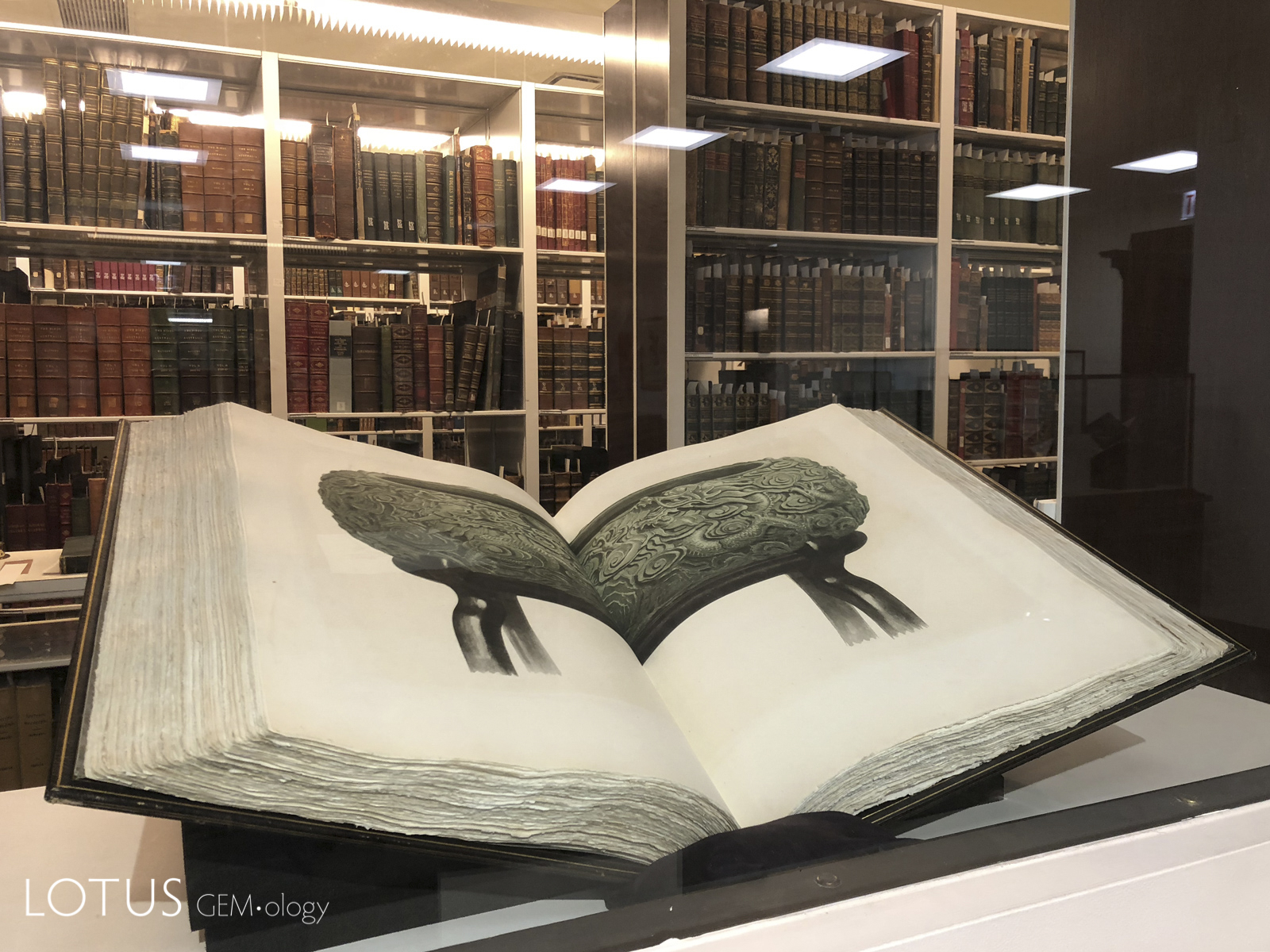 |
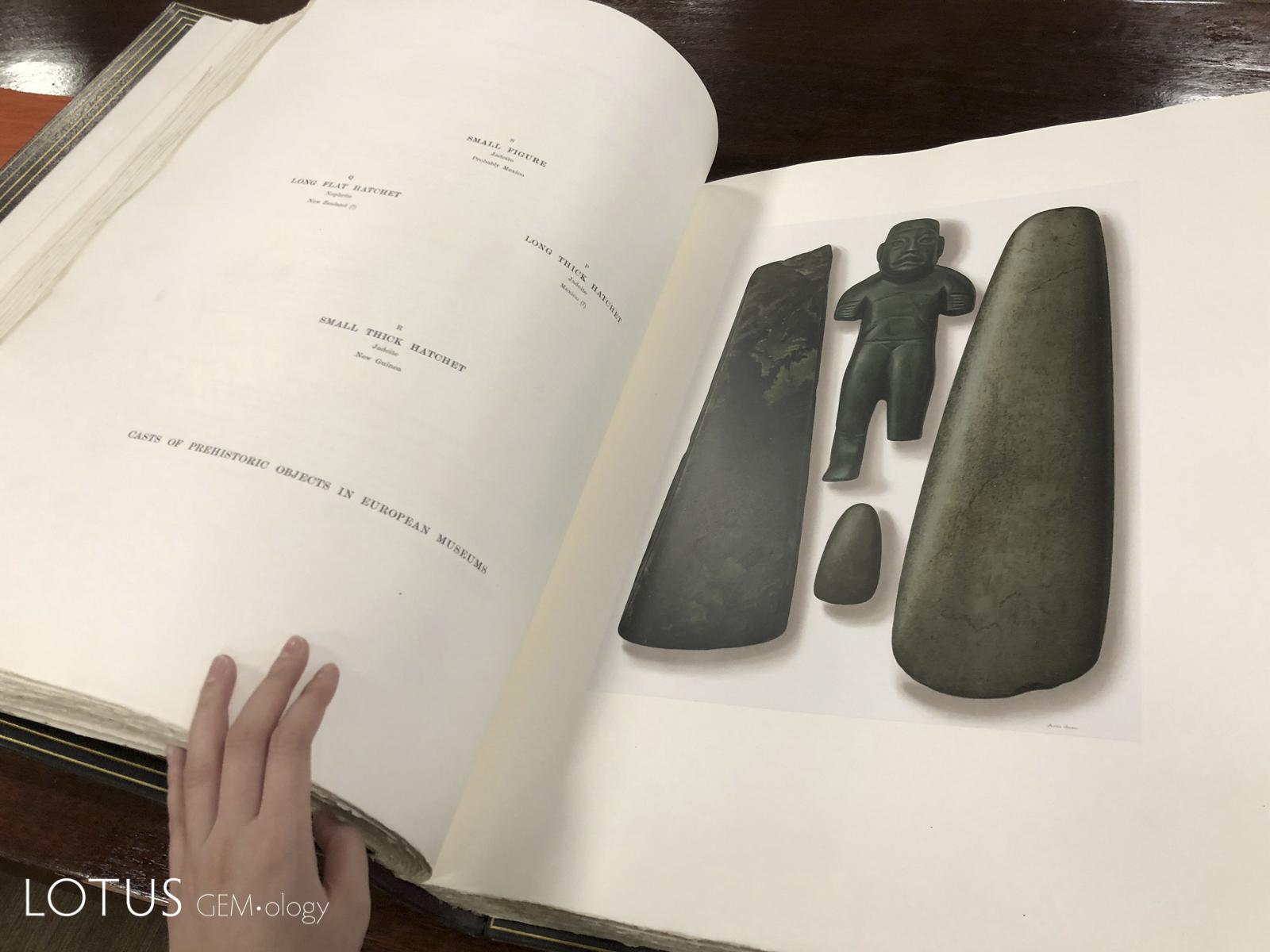 |
|
Two of the amazing lifelike plates from The Bishop Collection in the library of Chicago’s Field Museum. Photo: E. Billie Hughes. Click on the photos for larger images. |
|
Select references
- Bernstein, S. (2001) A passion for jade: Herber R. Bishop and his jade collection. Arts of Asia, Vol. 31, No. 6, Nov.–Dec., pp. 141–145.
- Bishop, H.R. (1906) The Bishop Collection: Investigations and Studies in Jade. New York: The Bishop Collection, 2 Vols., 277, 293 pp.
- Kunz, G.F. (1906b) The printed catalogue of the Heber R. Bishop collection of jade. New York, Occasional Notes, No. 11, Supplement to Bulletin of the Metropolitan Museum of Art, 8 pp.
- Sun, Z.J. (2016) A story of passion: Herber Bishop and his collection of jades. Arts of Asia, Vol. 46, No. 2, March–April, pp. 90–97.
General treatises of merit
Jade Lore (1936) views Chinese jades from a different perspective. Written by John Andrew Goette (1896–1974), a well-connected journalist on the scene during China’s tumultuous ‘30s, it covers the entire scope of Chinese jade in a very readable, non-academic style. Goette included a translation of Ch’en Hsing’s 1839 “brief but important treatise” Yu-chi (Records of Jade) plus more than 100 photographs of jades and jade carvers and one of the first jade color charts. The scarce Kelly and Walsh first edition was reprinted the next year by Reynal & Hitchcock, while the 1976 second edition by Ars Ceramica is more easily found and includes a greatly expanded Introduction and improved photographs.
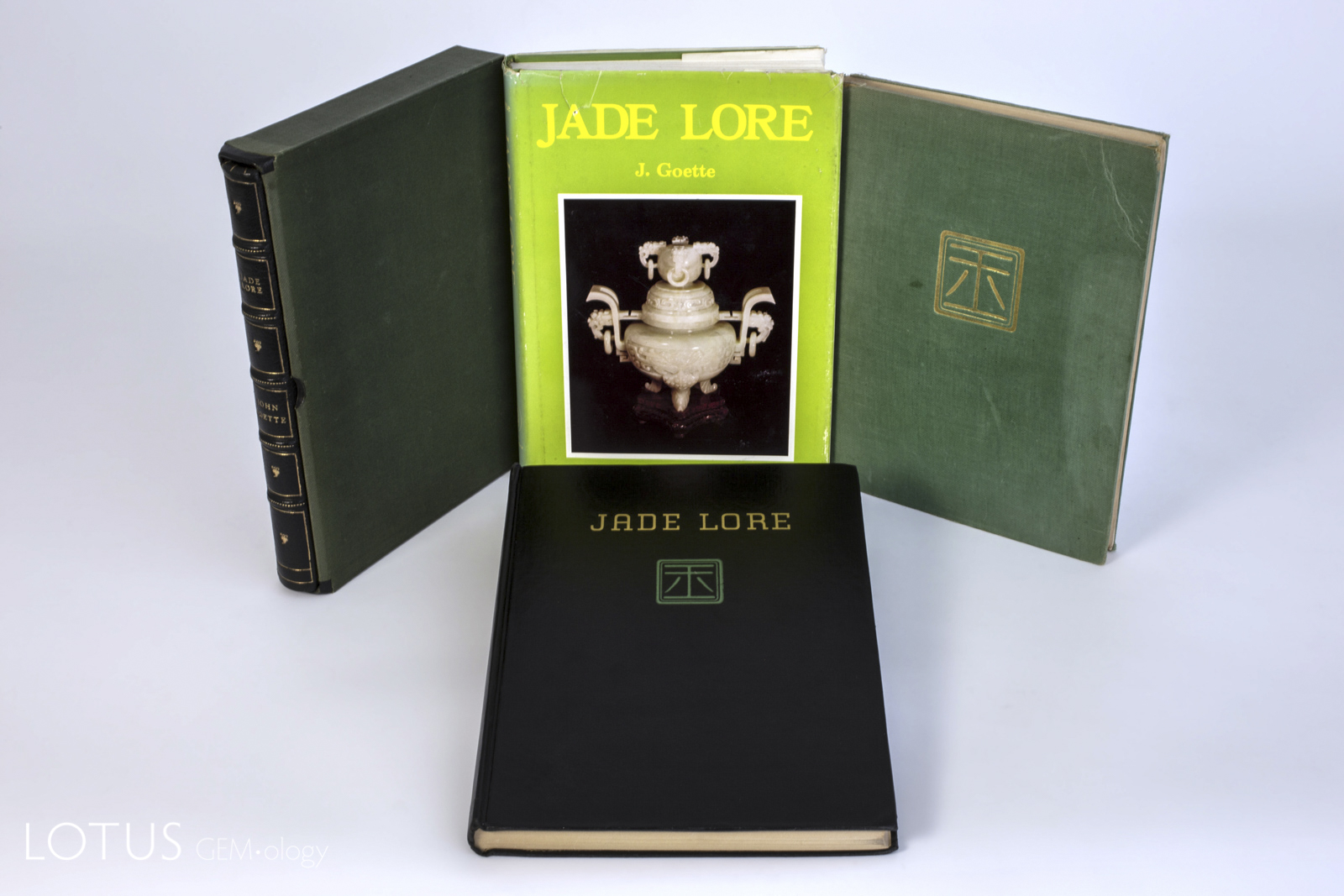 |
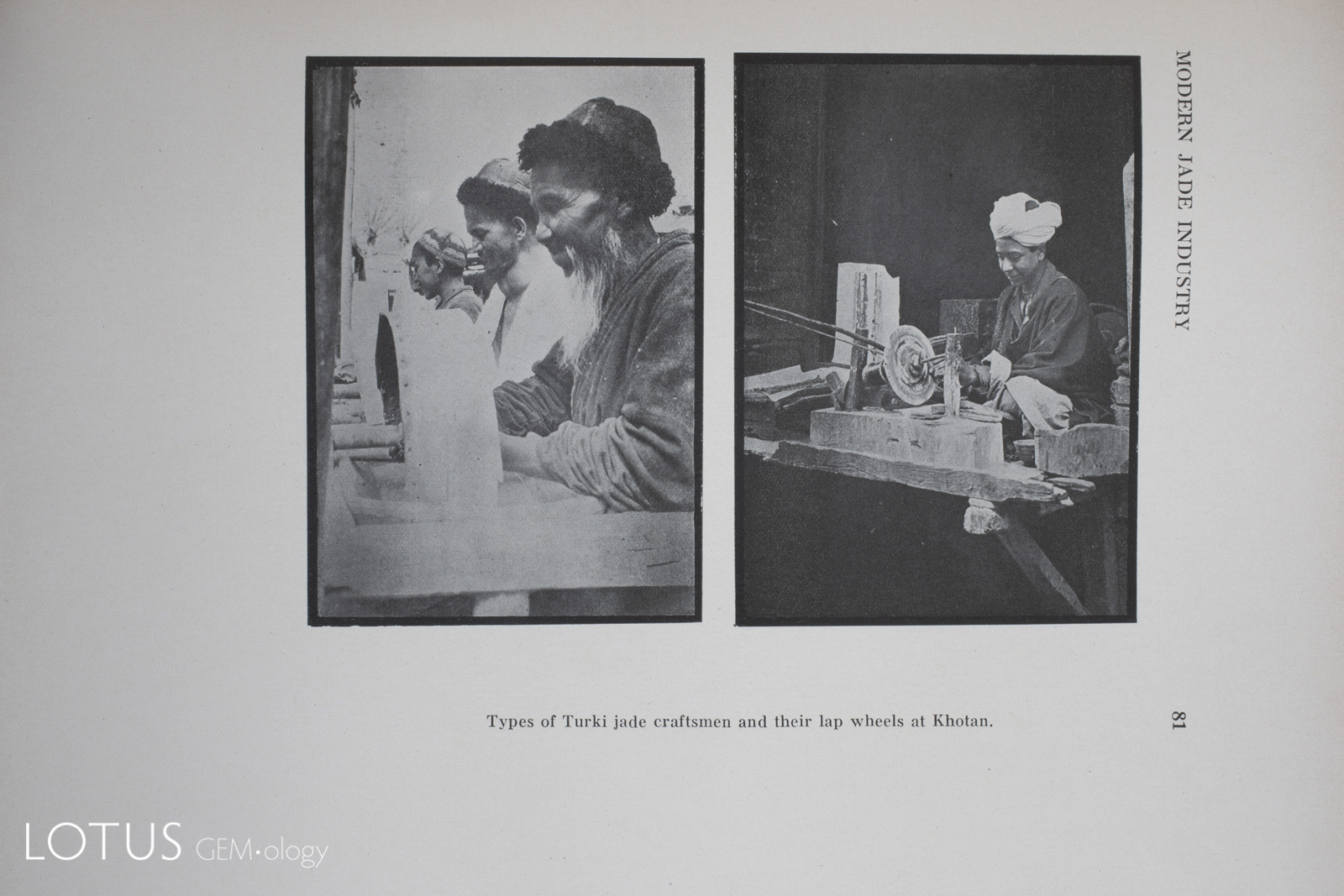 |
|
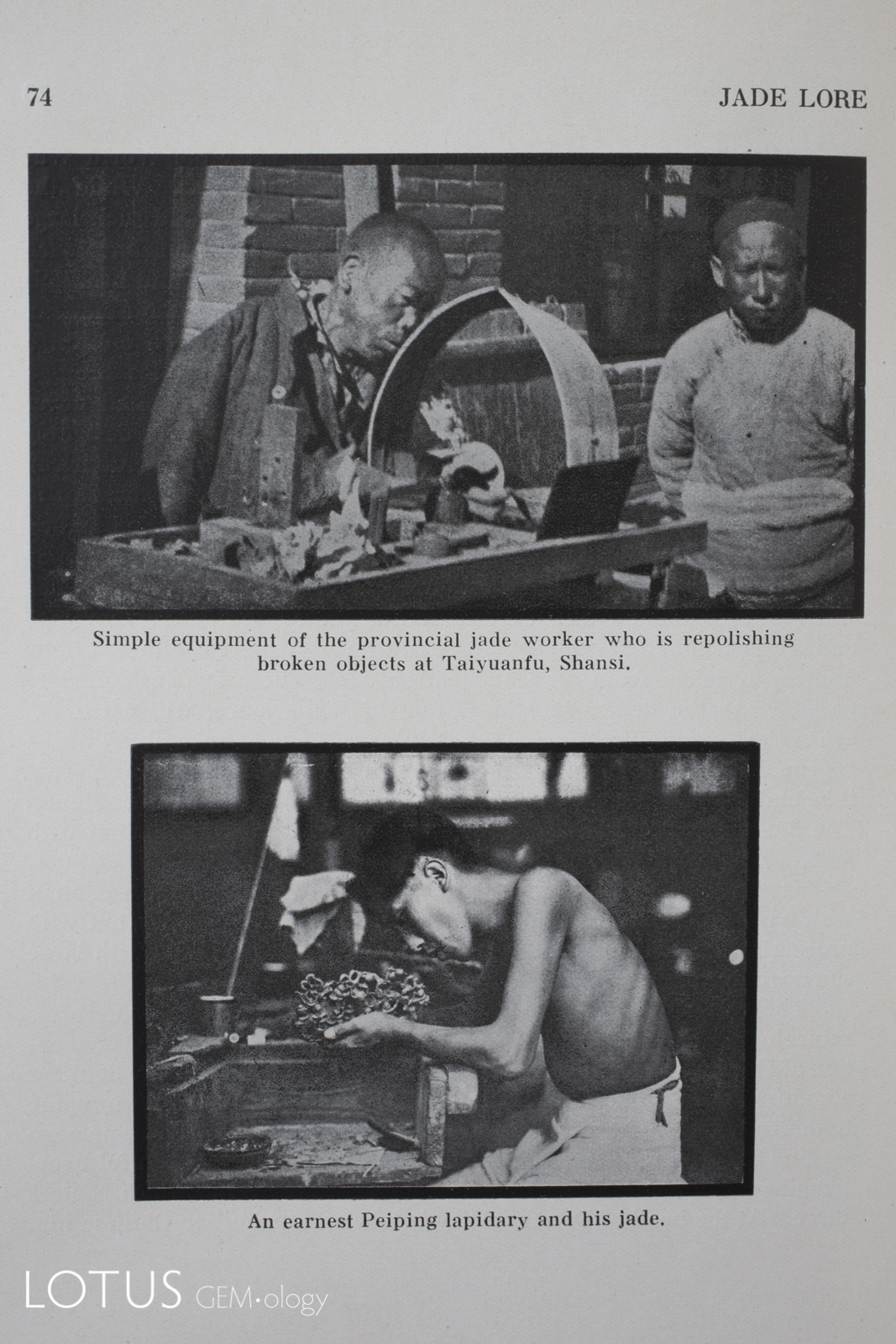 |
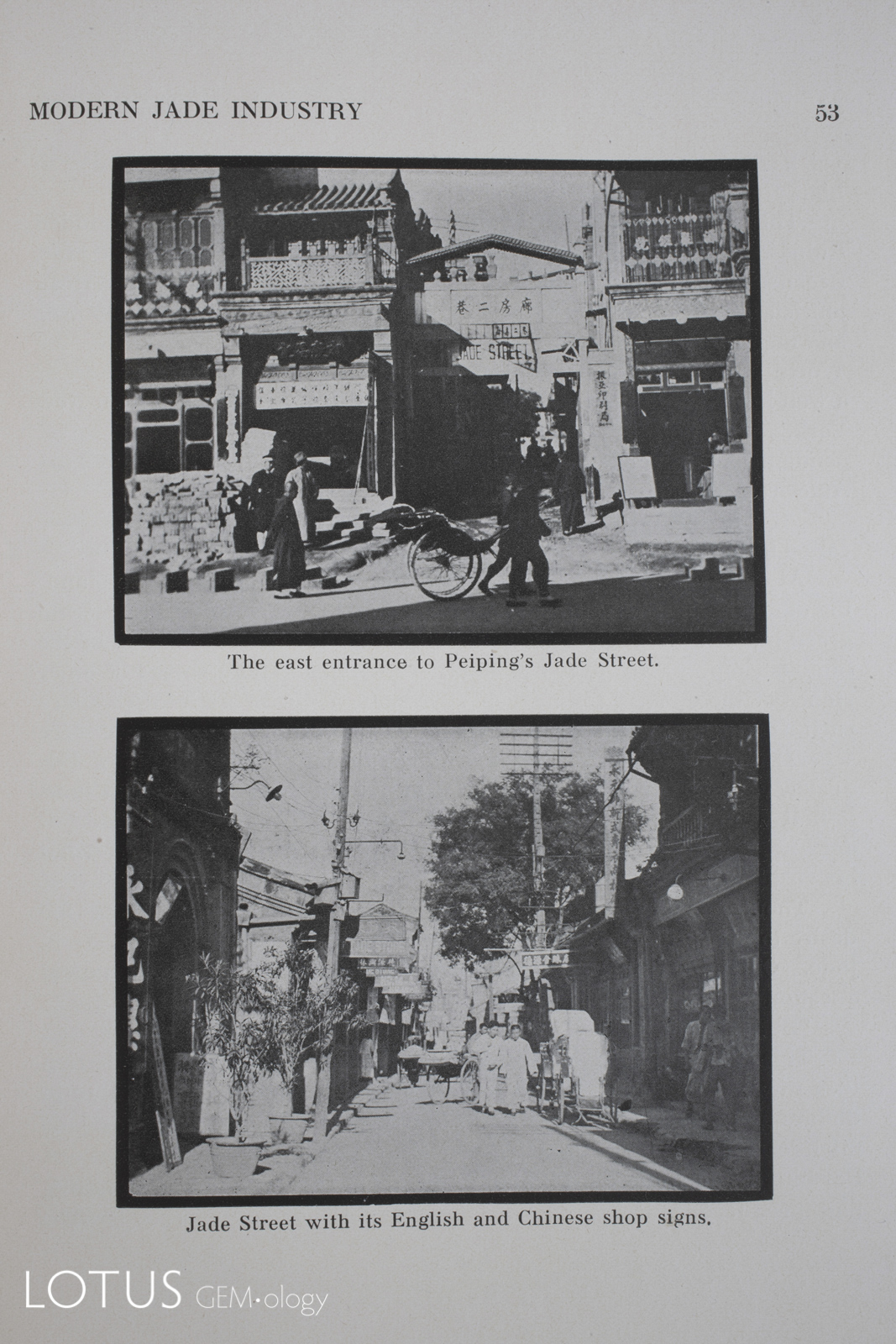 |
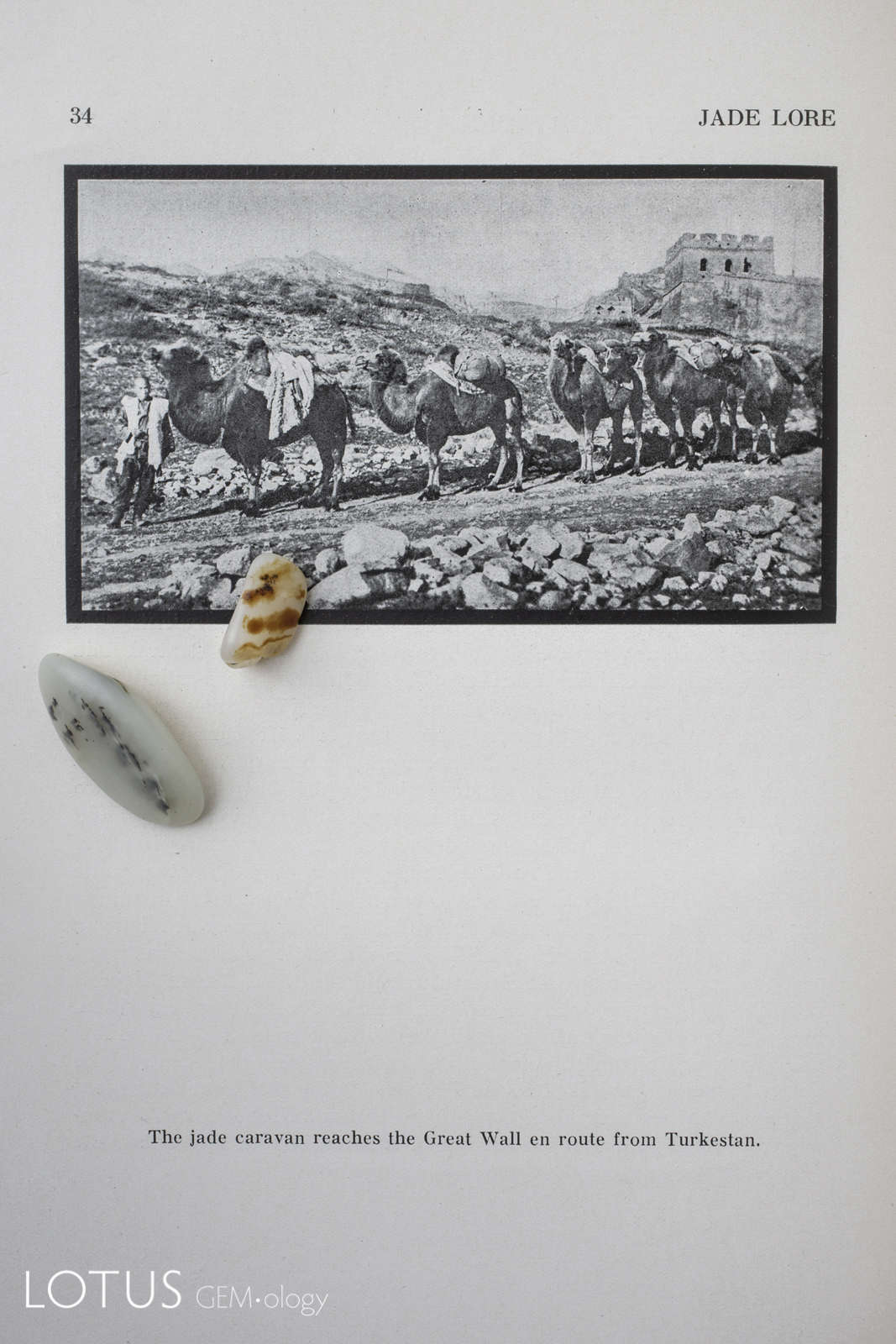 |
|
Top Left: One of the joys of book collecting is collecting different editions and printings. Here we see four versions of John Goette's Jade Lore. Clockwise from top left: custom leather binding of the 1936 Shanghai edition; the 1976 Ars Ceramica edition; the original 1936 edition and the 1937 Reynal & Hitchcock edition. Prior to the appearance of this book in 1936, only nine monographs on jade had been published in Occidental languages. |
||
Of the many later general books on jade, our favorite is Roger Keverne’s 1991 Jade. Designed as an update to The Bishop Collection, Keverne, a London gallery owner, assembled a world-class team of experts to weigh in on jade from around the globe. This is not just a tour de force of jade scholarship, but also features high quality printing and photography. Although out of print, copies are easily found.
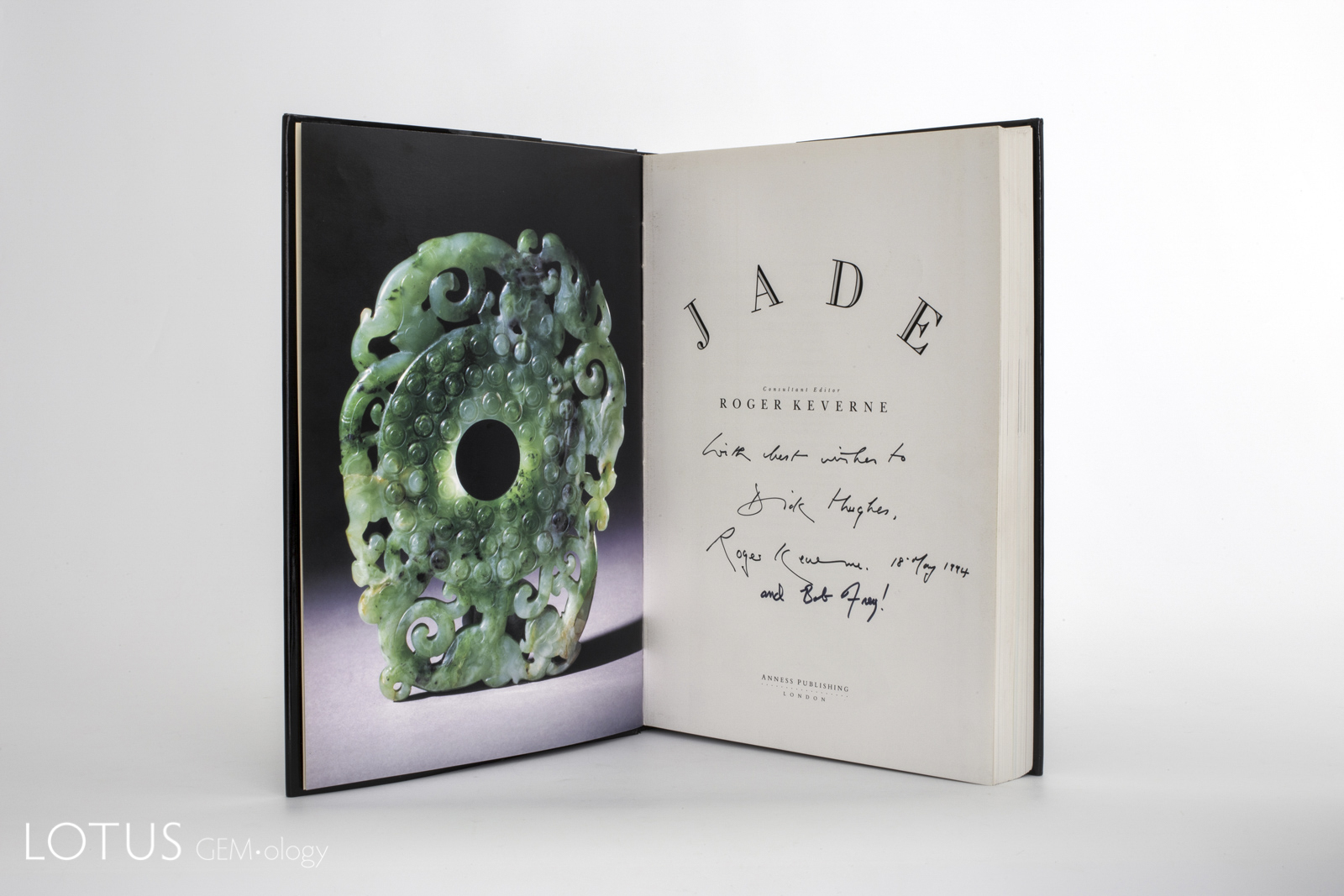 Roger Keverne's 1991 Jade brought together experts from around the world. It is arguably the finest modern work on jade. This copy is signed by two of the authors to Richard Hughes. Such "dedication" copies are generally more valuable, particularly if the person they are dedicated to is famous. Photo: Pinyo Khongsawad/Lotus Gemology Co. Ltd. Click on the photo for a larger image.
Roger Keverne's 1991 Jade brought together experts from around the world. It is arguably the finest modern work on jade. This copy is signed by two of the authors to Richard Hughes. Such "dedication" copies are generally more valuable, particularly if the person they are dedicated to is famous. Photo: Pinyo Khongsawad/Lotus Gemology Co. Ltd. Click on the photo for a larger image.
Not all readers are interested in scholarly books. Thankfully there are several great introductory works on jade. Only have time for one? We recommend Fred Ward’s Jade (Ward, 1996). Ward was a professional photographer who penned and illustrated numerous articles on gems for National Geographic magazine. Following that series, he self-published several small gem books with his wife, Charlotte. Ward’s book on jade arguably represents the best layman’s introduction to the subject.
Select references
- Goette, J. (1936) Jade Lore. Shanghai: Kelly & Walsh, reprinted in 1937 in China by Reynal & Hitchcock; reissued with new introduction by William C. Hu in 1976; Ann Arbor: Ars Ceramica, 321 pp.
- Keverne, R., ed. (1991) Jade. New York: Van Nostrand Reinhold, 376 pp.
- Ward, F. (1996) Jade. Bethesda, MD: Gem Book Publishers, revised 2001 and 2015, 64 pp.
Jadeite jade
Since its introduction to China in the Qing Dynasty, jadeite jade (from Myanmar) has become extremely popular, particularly among overseas Chinese in Hong Kong, Singapore, Taiwan, and Japan. Members of those communities have produced valuable works describing jadeite jade.
The earliest work on the subject is an extremely rare volume by Adamson. Penned in 1889, shortly after the British occupied Upper Burma, it represents the first Western eyewitness account of Burma’s jade mines. So rare is this tome that neither of the authors have ever seen a copy for sale. RWH did obtain a digital copy from a British library and can testify that this is an important work. It was issued with a lovely map, making it particularly collectible.
Another work of great importance is that of Hertz (1912). His gazetteer of the Myitkyina district includes a map, along with an extensive description of Burma’s jade mines and jade trade. Like all of the Burma Gazetteer series, this volume was reprinted in Burma in the 1960s. The originals are now incredibly rare and desirable.
When it comes to modern works on jadeite jade, a trio of books are worth mention. In the early 1980s, John Ng of California produced a color chart of jadeite types and qualities. It was so wildly popular among gemologists that he later penned an entire book on the subject (Ng & Root, 1984). Collectors should be aware that a limited edition also exists. Given the choice, seek out the limited edition.
In the last two decades, many other books on jadeite jade have appeared. Our favorite is written by Cecilia Lam of Hong Kong (Lam, 2005). The daughter of a jade trader, Ms. Lam does a wonderful job of introducing this arcane Chinese subject to international audiences. Although of recent vintage, today the book is extremely scare.
When discussing jadeite jade, we should also mention Mimi Ou Yang, who has authored a number of books in Chinese, and a couple in English. Those of a technical bent will find much of interest.
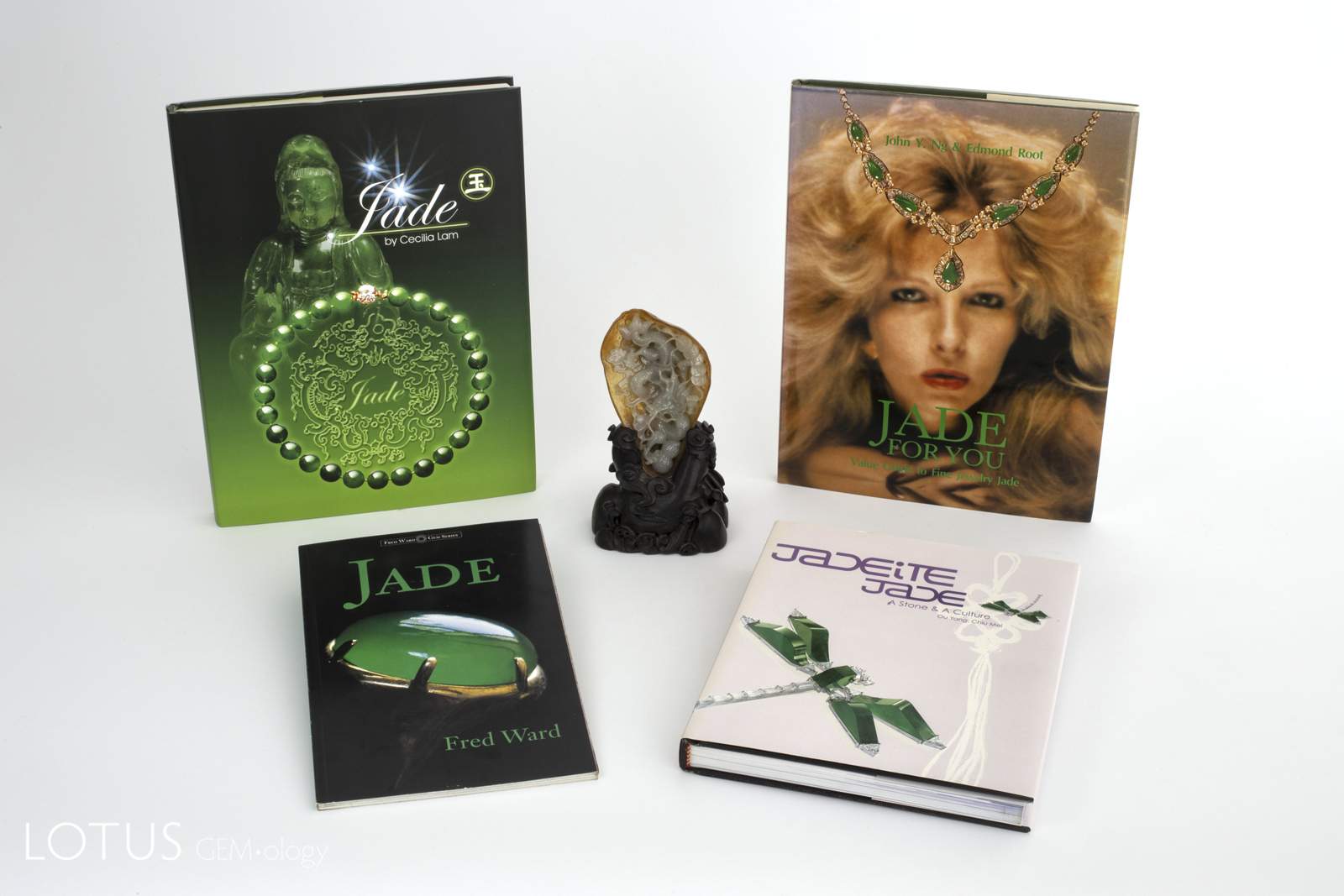 Four classic modern books on jade surround a Chinese carving in Burmese jade. Clockwise from top left: Jade by Cecilia Lam; Jade for You by John Ng & Edmond Root; Jade by Fred Ward, and Jadeite Jade: A Stone & a Culture by Ou Yang Chiu Mei. Photo: Pinyo Khongsawad/Lotus Gemology Co. Ltd. Click on the photo for a larger image.
Four classic modern books on jade surround a Chinese carving in Burmese jade. Clockwise from top left: Jade by Cecilia Lam; Jade for You by John Ng & Edmond Root; Jade by Fred Ward, and Jadeite Jade: A Stone & a Culture by Ou Yang Chiu Mei. Photo: Pinyo Khongsawad/Lotus Gemology Co. Ltd. Click on the photo for a larger image.
Select references
- Adamson, C.H.E. (1889) A Short Account of an Expedition to the Jade Mines in Upper Burma, in 1887–1888. Newcastle-upon-Tyne: J. Bell & Co., 65 pp., map.
- Hertz, W.A. (1912) Burma Gazetteer: Myitkyina District. Rangoon: Superintendent, Govt. Printing and Staty., Volume A, reprinted 1960, 193 pp., map.
- Lam, C. (2005) Jade. Hong Kong: Lead On Publishing Co., 253 pp.
- Ng, J.Y. and Root, E. (1984) Jade for You: Value Guide to Fine Jewelry Jade. Los Angeles: Jade N Gem Corp. of America, 107 pp.
- Ou Yang, C.M. (2003) Jadeite Jade: A Stone & a Culture. Hong Kong: Yang Mulia Gems Ltd., 1st edition, 184 pp.
Jade carving and lapidary
One of the first authors to take a serious academic interest in jade was S. Howard Hansford (1899–1973). He studied under renowned sinologist W. Perceval Yetts and succeeded him as professor of Chinese Art and Archeology at the University of London. Although his teacher’s specialty was Chinese bronzes, Hansford soon developed a serious interest in Chinese jades. Working for his family’s business in the 1930s, he took advantage of that time to visit and photograph Beijing jade carvers at work.
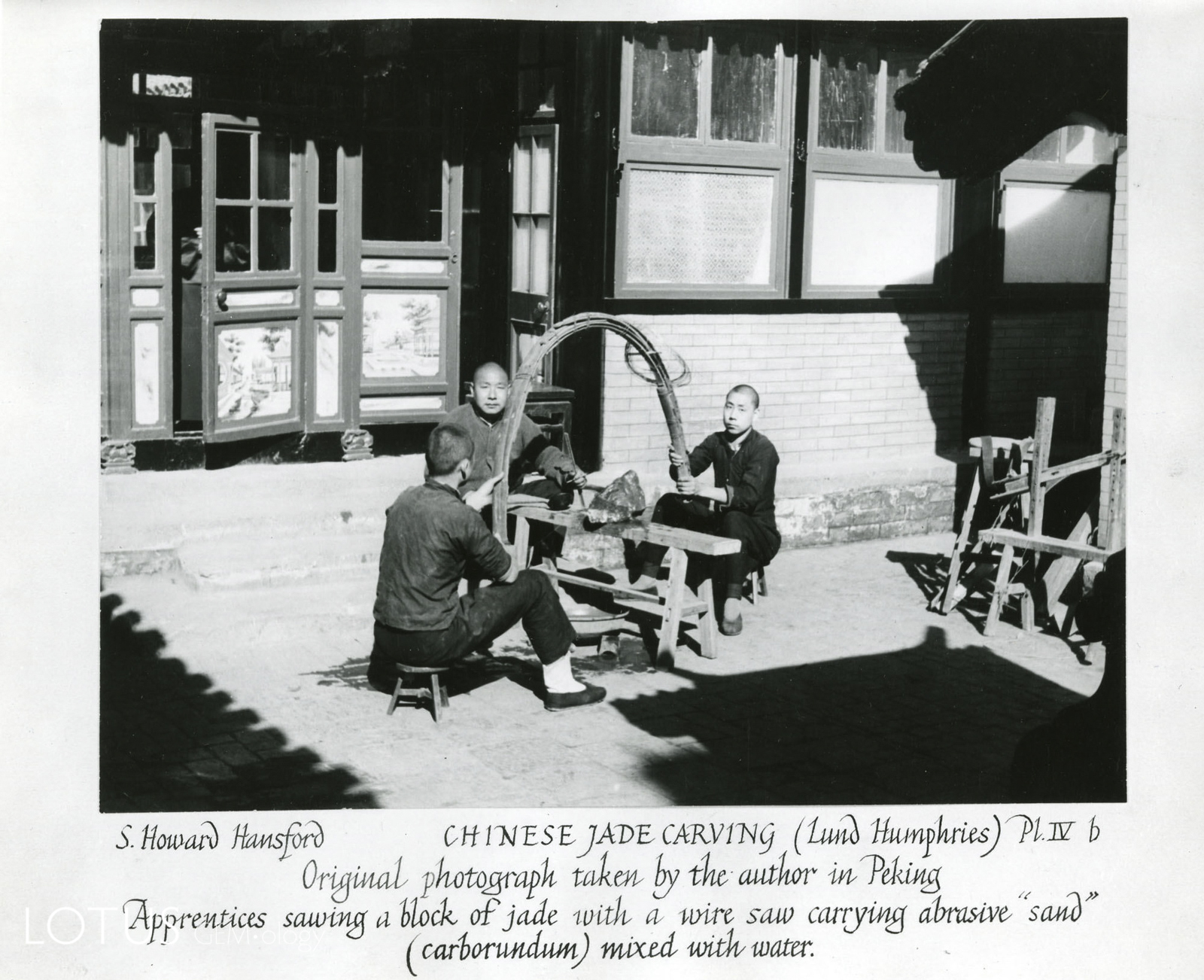 A print that was featured in S. Howard Hansford's 1950 classic, Chinese Jade Carving. Nephrite jade is so tough that, according to Hansford (p. 79), two men in a 20th century Beijing workshop took several weeks to saw through a one cubic foot (30.5 cm) piece.
A print that was featured in S. Howard Hansford's 1950 classic, Chinese Jade Carving. Nephrite jade is so tough that, according to Hansford (p. 79), two men in a 20th century Beijing workshop took several weeks to saw through a one cubic foot (30.5 cm) piece.
Hansford’s first book on the subject was Chinese Jade Carving (1950), his classic study on jade mineralogy and Chinese carving techniques. He also studied Maori jade working techniques, from which he inferred the methods of Neolithic Chinese jade carvers. His second major book was Chinese Carved Jades (1968), a more popularized treatment updated with color illustrations. Much of what we know about Chinese jades today was first set forth in these books. Hansford also published several jade-related monographs, including his discussion of one of the more puzzling pseudojades, What Is Nan-Yang Yu? (1965).
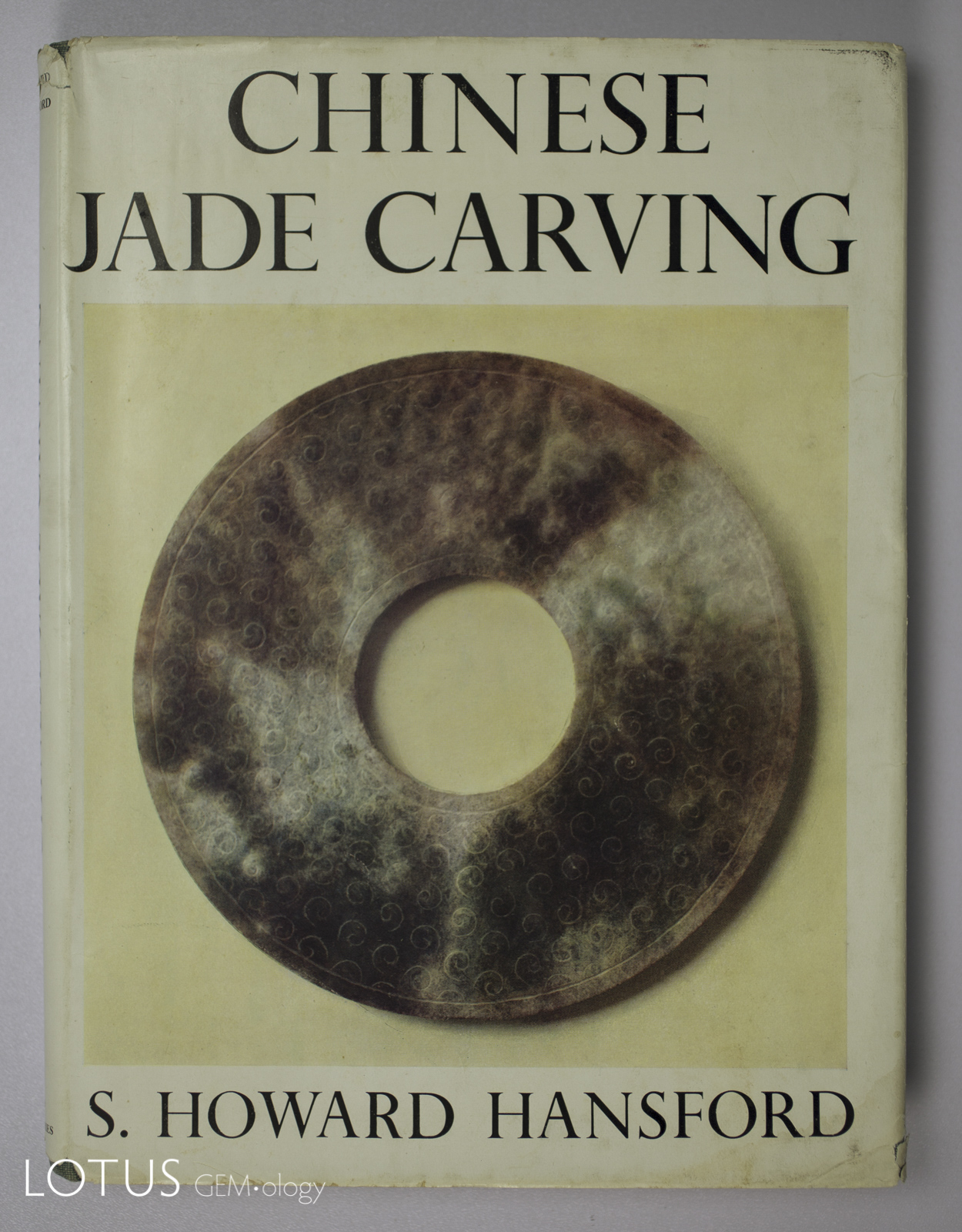 Dust jacket of S. Howard Hansford's 1950 Chinese Jade Carving, a classic work on the subject. Photo: Pinyo Khongsawad/Lotus Gemology Co. Ltd. Click on the photo for a larger image.
Dust jacket of S. Howard Hansford's 1950 Chinese Jade Carving, a classic work on the subject. Photo: Pinyo Khongsawad/Lotus Gemology Co. Ltd. Click on the photo for a larger image.
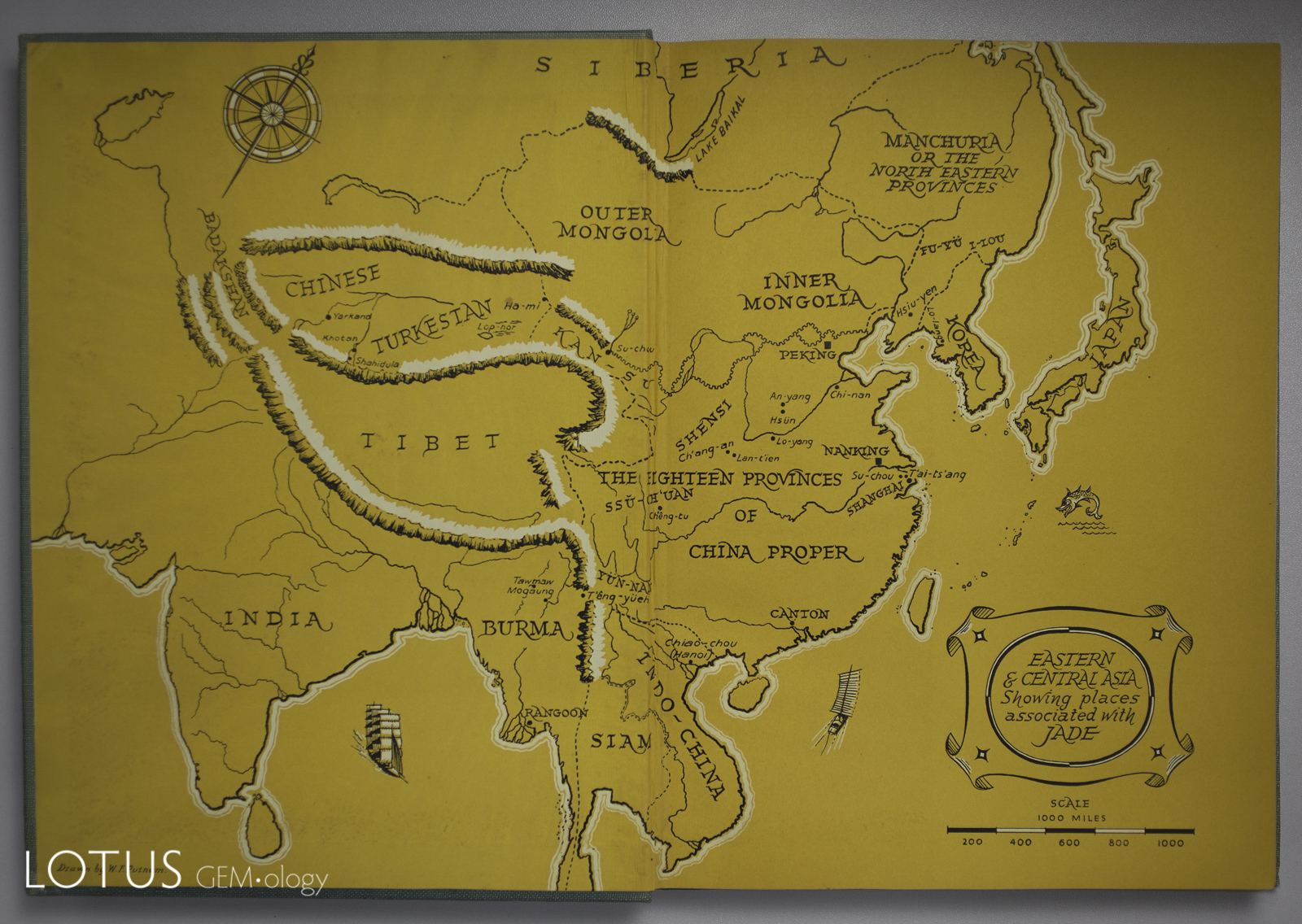 Front end papers of S. Howard Hansford's 1950 Chinese Jade Carving, showing the important jade mines and carving centers. Photo: Pinyo Khongsawad/Lotus Gemology Co. Ltd. Click on the photo for a larger image.
Front end papers of S. Howard Hansford's 1950 Chinese Jade Carving, showing the important jade mines and carving centers. Photo: Pinyo Khongsawad/Lotus Gemology Co. Ltd. Click on the photo for a larger image.
Hansford cataloged two fine jade collections, the hardest to find being Jade, Essence of Hills and Streams: The Von Oertzen Collection of Chinese and Indian Jades (1969). Published in Cape Town, it was once banned from several countries due to the apartheid policies. About half of this catalog’s jades are pre-Han, plus 115 Qing examples (some probably Imperial) and a section on Indian and Persian jades.
New Zealand has birthed the most important jade carving center outside of China. Often based on Maori lines, the carvers in this remote location brought energy and excitement at a time when the Middle Kingdom’s artistry had largely gone dormant. Perhaps the best-known practitioner of carving in New Zealand is Donn Salt, and he has also authored the best book on the subject: Stone, Bone and Jade: 24 New Zealand Artists. Published only as a slim paperback in 1992, the 95 pages may have you believing the best modern jade carving is in New Zealand.
Or not. While China’s carving artistry largely rested on its laurels for the latter part of the 20th century, the dragon has roared back in the past three decades, reaching an extraordinary level of achievement. Two series of books have documented this astonishing rebirth. The first, 中国玉雕·石雕作品"天工奖"典藏集 [Chinese Jade Carving & Stonework “Tiangong Award” Collection], has been published yearly since 2003 and features photographs of all of the Tiangong Award finalists. This annual contest recognizes the finest in carving in jade, coral and other hard stones. From the same publisher also comes the 中国玉石 [Chinese Master of Jade Carving] series, each volume of which focuses on the work and philosophy of individual carving masters such as Wu Desheng, Ma Hongwei and Yang Xi. Both series couple top-notch color photography with art book printing and binding, along with carvings that will have you forgetting every tired Guanyin statue you’ve ever seen.
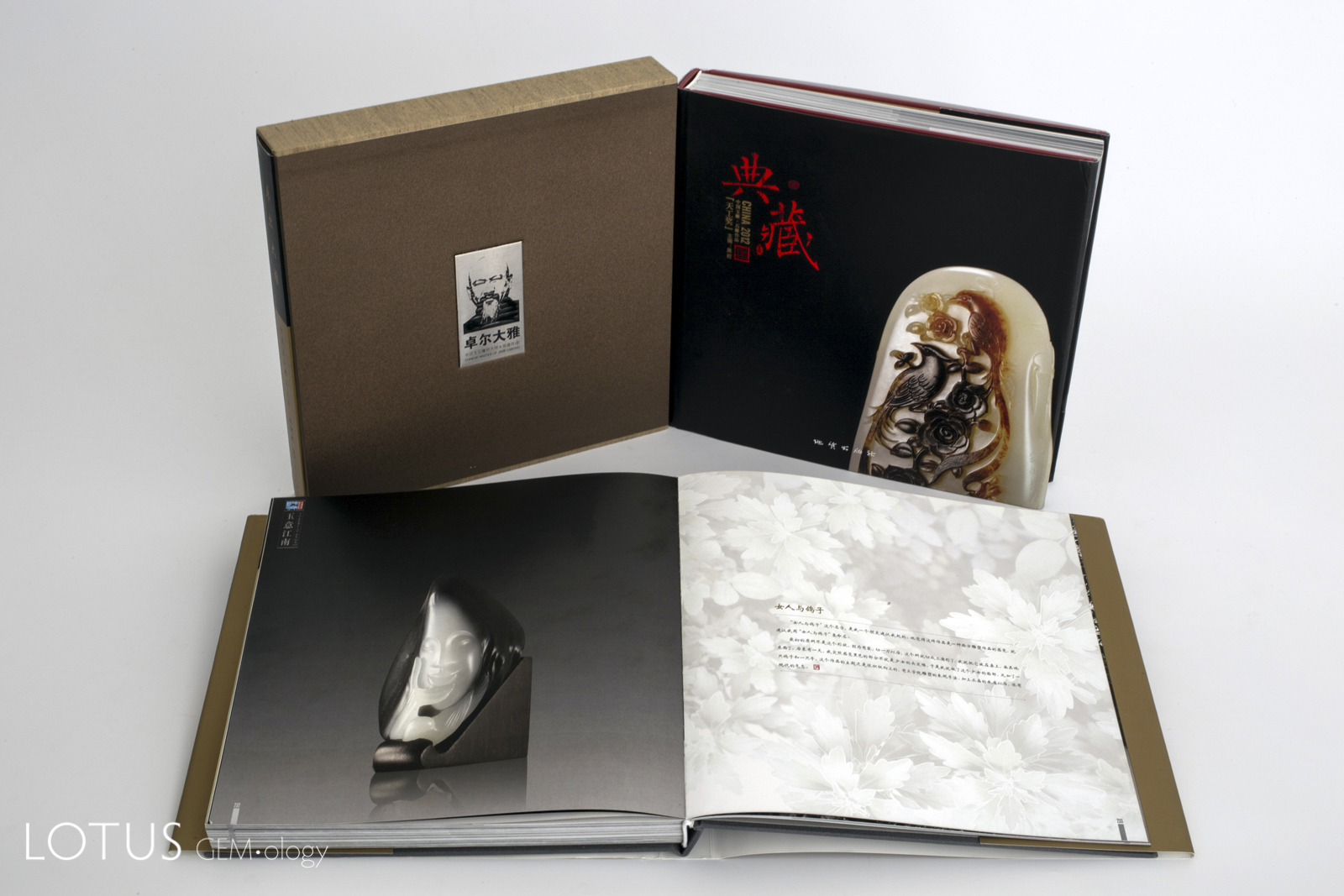 Chinese University of Geosciences Press has issued two sumptuous ongoing series on modern jade carving, one dedicated to individual master carvers (top left and below) and the other covering the annual Tiangong Awards, the Oscars of Chinese stone carving. Photo: Pinyo Khongsawad/Lotus Gemology Co. Ltd. Click on the photo for a larger image.
Chinese University of Geosciences Press has issued two sumptuous ongoing series on modern jade carving, one dedicated to individual master carvers (top left and below) and the other covering the annual Tiangong Awards, the Oscars of Chinese stone carving. Photo: Pinyo Khongsawad/Lotus Gemology Co. Ltd. Click on the photo for a larger image.
Select references
Hansford, S.H. (1950) Chinese Jade Carving. London: Lund Humphries & Co., 145 pp., 132 plates.
Hansford, S.H. (1965) What Is Nan-Yang Yu? Asia Major, New Series, Vol. 11, Part 2, pp. 160–165.
Hansford, S.H. (1968) Chinese Carved Jades. Greenwich, CT: New York Graphic Society, 131 pp.; 196 plates.
Hansford, S.H. (1969) Jade: Essence of Hills and Streams. Johannesburg: Purnell and Sons, 220 pp.
Salt, D. (1992) Stone, Bone and Jade: 24 New Zealand Artists. Auckland: David Bateman, 95 pp.
Yan, A.奥., ed. (2009–2016) 中国玉石 [Chinese Master of Jade Carving]. [in Chinese], Chinese Master of Jade Carving, Beijing: China University of Geosciences Press, 19 Vols., [various paginations].
Yan, A.奥., ed. (2003–2018) 2002–2017中国玉雕·石雕作品"天工奖"典藏集 [Chinese Jade Carving & Stonework “Tiangong Award” Collection]. [in Chinese], Beijing: 中国地质大学出版社 [China University of Geosciences Press], various paginations.
|
Profile: Stanley Charles Nott (1902–1958?)
British-born Dr. Stanley Charles Nott was a prominent authority on rare Chinese jades and author of several classic jade texts in the mid-20th century. In addition to a number of substantial books, he published his lectures on jade, such as An Illustrated Annotation on the Working and Dating of Chinese Jades (1941), as well as numerous booklets from the House of Jade that he and his wife Lucille jointly ran in Palm Beach, Florida. Following Nott’s death, Lucille sold his impressive personal collection of jade to what is now the Norton Museum in Florida and moved the store to New York City. Nott is best known for his classic 1936 work Chinese Jade Throughout the Ages, with 39 color plates, 109 black and white photographs, and 73-line engravings. The Batsford first edition is now scarce. A first American edition followed in 1937, and in 1962 Tuttle reissued this highly respected reference through at least 12 printings. His next book was Chinese Jade Carvings of the XVIth to the XIXth Century, in the Collection of Mrs. Georg Vetlesen (1939–40). The Vetlesen jades once occupied a dedicated gallery at the Smithsonian Museum of Natural History. Produced for private circulation only, this set of three large volumes illustrates 134 mostly Qing dynasty jades with black and white plates. It is now scarce, especially in the leather-bound edition. Several more books followed, including A Catalogue of Rare Chinese Jade Carvings (1940), An Expository Historical Resumé Identifying One Hundred and One Famous Chinese Jades (1941), Chinese Art of World Renown (1944), Chinese Culture in the Arts (1946), and Voices from the Flowery Kingdom (1947). But the most massive of the Nott books was his Chinese Jades in the Collection of Stanley Charles Nott (1942; 536 pp, 107 jades illustrated in 118 full-page black and plates plus 123-line engravings). One-thousand copies of this book were printed; they are now scarce. Select references
Charles Stanley Nott was perhaps the most prolific 20th century writer on jade. Here are four of his most collectable titles. In the foreground is his 1936 Chinese Jade Throughout the Ages. Note that two of these books feature dust jackets, which adds value, as so many were discarded. Photo: Pinyo Khongsawad/Lotus Gemology Co. Ltd. Click on the photo for a larger image. A plate illustrating jade cutting from Charles Stanley Nott's 1941 book, An Illustrated Annotation on the Working and Dating of Chinese Jades. Photo: Pinyo Khongsawad/Lotus Gemology Co. Ltd. Click on the photo for a larger image. |
Jades from the rest of the world
Outside of China, perhaps the best-known examples of the use of jade (nephrite) are in New Zealand, first by the Maori people and later in modern jade carvings of sometimes exquisite beauty. One of the finest books on New Zealand jade is Russell Beck and Maika Mason’s Pounamu: The Jade of New Zealand, published in 2010. Featuring the sumptuous landscape photography of Andris Apse, this is not only a comprehensive history of jade in New Zealand, but also a joy to simply browse through. Collectors should seek out the original 2010 hardback edition, not the 2015 abridged edition.
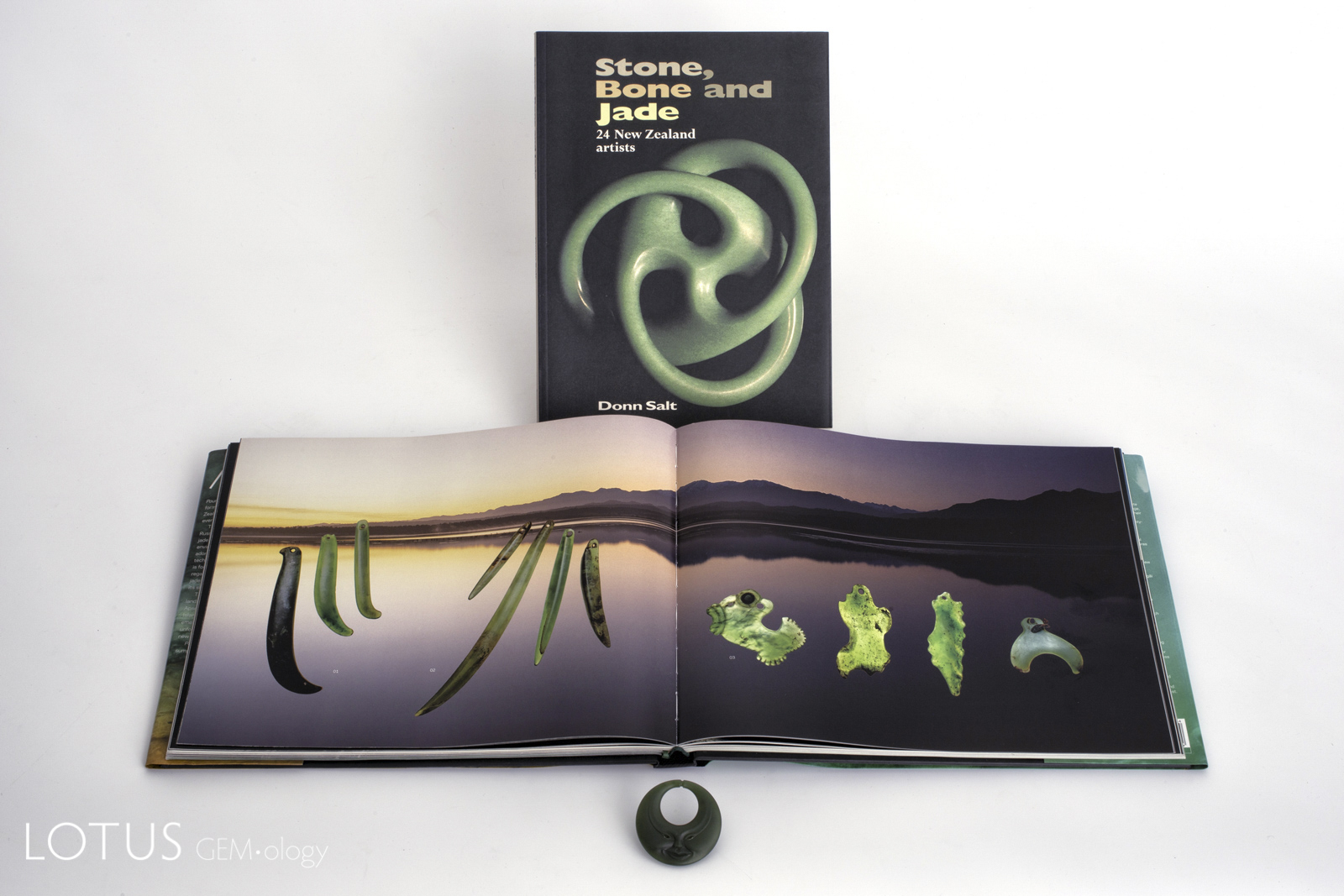 Master carver Donn Salt's book on New Zealand carving sits above a spread from Beck and Mason's lavish 2010 Pounamu: The Jade of New Zealand. In the foreground is an original Donn Salt carving in New Zealand nephrite jade. Photo: Pinyo Khongsawad/Lotus Gemology Co. Ltd. Click on the photo for a larger image.
Master carver Donn Salt's book on New Zealand carving sits above a spread from Beck and Mason's lavish 2010 Pounamu: The Jade of New Zealand. In the foreground is an original Donn Salt carving in New Zealand nephrite jade. Photo: Pinyo Khongsawad/Lotus Gemology Co. Ltd. Click on the photo for a larger image.
The ancient Olmec, Maya, and other Mesoamerican cultures used jade for artistic and ritual purposes, beginning around the same time as China’s Zhou dynasty (1046–256 BCE). An impure jadeite was the stone of choice and meticulous work was accomplished without benefit of metal tools. Among several excellent books on the subject, a good overview can be found in Fred Ward’s Jades of Mesoamerica, but this is now hard to find. More available is Easby’s Pre-Columbian Jade from Costa Rica and the Metropolitan Museum of Art’s Jade in Ancient Costa Rica. Balser’s Jade Precolombino de Costa Rica (in Spanish and English) features 160 carved jade artifacts from the world’s largest jade museum, in San José, Costa Rica. And a concise introduction to Mayan jades can be found in Adrian Digby’s Maya Jades.
Select references
- Balser, C.S. (1980) Jade Precolombino de Costa Rica. San José, Costa Rica: Instituto Nacional de Sequros, 130 pp.
- Beck, R.J. and Mason, M. (2010) Pounamu: The Jade of New Zealand. Rosedale, New Zealand: Penguin Group New Zealand, Limited, 237 pp.
- Digby, A. (1972) Maya Jades. London: Trustees of the British Museum, reprinted 1978, 32 pp.
- Easby, E.K. (1968) Pre-Columbian Jade from Costa Rica. New York: André Emmerich Inc., 101 pp.
- Emmons, G.T., ed. (1923) Jade in British Columbia and Alaska, and its Use by the Natives. Indian Notes and Monographs, New York: Museum of the American Indian Heye Foundation, 158 pp.
- Jones, J., ed. (1998) Jade in Ancient Costa Rica. New York: Metropolitan Museum of Art, 127 pp.
- Salt, D. (1992) Stone, Bone and Jade: 24 New Zealand Artists. Auckland, David Bateman, 95 pp.
- Ward, F. (1997) Jades of Mesoamerica. Bethesda, MD: Gem Book Publishers, 16 pp.
Museum collections
Several fine books document famous museum jade collections. How to choose? In this case one of the best was one of the first: The National Palace Museum Masterworks of Chinese Jade duo. Part of the acclaimed 25-volume “Masterworks” series from NPM published from 1969 to 1974, these two volumes depict the top 100 jades in the museum’s outstanding collection. The jades range from Shang dynasty to Qing and include Emperors’ favorites spanning hundreds of years. Included are two of the museum’s famous “Three Treasures”: The Pork-shaped Stone and the beloved Jadeite Cabbage. The books are printed in English, Chinese, and Japanese and are attractively slipcased. Long out of print but still relatively easy to find.
Select references
- National Palace Museum (1969) Masterworks of Chinese Jade in the National Palace Museum. Taipei: National Palace Museum, 92 pp.
- National Palace Museum (1973) Masterworks of Chinese Jade in the National Palace Museum: Supplement. Taipei: National Palace Museum, 86 pp.
|
Book collecting notes Not unlike art collecting, book collectors and dealers have developed a specialized vocabulary to describe the works they collect, buy and sell. Rarity vs. demandWhat is a rare book? Most would agree that it is a title for which one cannot readily find a single copy on any major book search engine (Bookfinder.com, viaLibri.net, AbeBooks.com, Biblio.com, etc.). Rare books are those that collectors see offered for sale only once in a few decades. Scare books are those that appear only once every few years. But rarity alone does not make a book valuable. Price also depends on demand, which is influenced by current events, fashion, the economy, etc. Something can be exceedingly rare, but if it is so obscure that there is no demand for it, the price still may be low. Some of the rarest collectibles are ephemera. These are magazines, pamphlets, brochures and other items that are generally discarded over time. Thus, their rarity. Book editionsDust Jacket (dust wrapper): Since the early 19th century, many books were issued with dust jackets. Originally rather plain in design, these have evolved into the sometimes-elaborate wrappers of the modern era. Because these were often damaged or even discarded by purchasers, their presence and condition can have a dramatic effect on a book’s value and collectability. Collectors should always look for books where the dust jacket is both present and in the best possible condition. First Edition: In most cases, the first appearance of a book (known as the first edition) is the most collectible. However, where significant improvements are made to later editions, the reverse can be true. Limited Edition: This refers to any book where the publication is deliberately restricted to a specific number of copies. These are usually numbered and signed by the author and may have special features (such as leather bindings and/or slipcases). Because of their rarity and the fact that they are often purchased by collectors who take exceptional care of them, limited editions often fetch two-to-five times more than the price of standard editions. Signed Editions: Generally, copies signed by the author are worth more than unsigned copies, because they are rarer. The difference in value goes up with the rarity of the book, as well. Association Copy: This is where the book can be provably associated with the author, or a friend, relative or collaborator of the author. The more famous, the better! Dedication Copy: This is a copy signed by the author to a third party, again, the more famous the recipient the better. ConditionUsed books are generally graded on the following descending scale (as discussed at Alibris.com): New: A book in perfect condition, as direct from the publisher. As New (mint): Identical to new, immaculate and without any flaws, showing only the slightest use. Fine: Signs of slight use, but complete as issued (meaning the dust jacket, if any, is present and also in fine condition). Very Good: Signs of use, but still attractive. All pages and cover are intact (including the dust jacket). Good: All pages and cover are intact (including the dust cover, if applicable). Possible slightly loose bindings, minor highlighting and margin notes, cocked spine or torn dust jackets are acceptable. Loose pages are not. Fair: Obviously well-worn, but no text pages missing. May be without endpapers or title page. Markings do not interfere with readability. Dust jacket may be torn or missing. Poor: Extensive signs of wear; torn or missing dust jacket; may have missing pages; a reading copy only. Ex-Library: This refers to books which were once part of a formal library. Generally speaking, ex-library books will never be better than “good” in terms of condition, because they have been handled a lot and have stamps, card pockets, etc. Collectors should only buy these books if no other copy is available. Collectors should purchase books in Very Good or better condition. As with all collectibles, condition is king. In some cases, the dust jacket may be worth more than the book itself. Look for books with the dust jacket present, and once you make a purchase protect your dust jackets with archival quality acid-free covers (sold by Brodart in the US). A final word on condition. Not unlike art merchants, book dealers may vastly overstate a book’s condition. This leads to sometimes comical descriptions, such as: Sunning to spine, some pages show foxing, slight musty smell, pen underlining throughout, owner’s name on front endpaper, no dust jacket, last ten pages missing, otherwise as new. |
Conclusion: Why collect books?
People cultivate jade, and jade cultivates people.Chinese Proverb
The world of book collecting is vastly satisfying, particularly when it is coupled with building a jade collection. In closing, we will conclude with a few words from Wendell Wilson, former editor of the Mineralogical Record, who beautifully summarized the nexus between collecting itself and collecting books on the same subject:
Why should [a collector] divide his time and money by taking on a second major field of collecting? I can only answer by pointing out that when we admire a new specimen, the sensuous aesthetic pleasure and the intellectual stimulation we feel are simply the consequence of our eyes and hands taking in information about that [piece]. But there is a limit to what we can take in on our own, with just ourselves and the specimen. We can break through that barrier with books, so as to be able to take in the vast amount of data gathered by others and thereby continue the pleasurable process. And in doing so we extend our horizon to include the culture of [these objects], a step which humanizes the whole experience.
– Wendell E. Wilson, 1995
Mineral Books: Five centuries of mineralogical literature
What we particularly appreciate about Wilson’s words is his reference to “humanizing” the collecting experience. Without people, jade carvings and objects would have no more value than any other chemical compound on the planet. It is the human experience that discerns, derives and discovers beauty and value in what our planet has bequeathed to us. Without this element, there is no value. With it, the world is not just our oyster, but a pearl quite beyond.
Further reading
Interested in more? The following are but a few other collectible and/or important nuggets in the jade book œuvre.
- Bernstein, S. (1995) Collecting Chinese Jade. San Francisco: S. Bernstein & Co., 107 pp.
- Best, E. (1912) The Stone Implements of the Maori. Dominion Museum Monograph No. 4, Dominion Museum/John Mackay Govt. Printer, 410 pp.
- Forsyth, A. and McElney, B.S. (1994) Jades from China. Bath, England: Museum of East Asian Art, 423 pp.
- [various authors], (1980–2002) [Entire issues devoted to jade]. Bulletin of the Friends of Jade, Vols. 1–10.
- Gu Fang [古方] (2005) 中國出土玉器全集/The Complete Collection of Jades Unearthed in China. [in Chinese and English], Beijing: Science Press, 15 Vols., Vol. 1. Beijing, Tianjin & Hebei; 2. Inner Mongolia, Liaoning, Jilin & Heilongjiang; 3. Shanxi; 4. Shandong; 5. Henan; 6. Anhui; 7. Jiangsu & Shanghai; 8. Zhejiang; 9. Jiangxi; 10. Hubei & Hunan; 11. Guangdong, Guangxi, Fujian, Hainan, Hong Kong, Macau, & Taiwan; 12. Yunnan, Guizhou, and Xizang; 13. Sichuan & Chongqing; 14. Shaanxi; 15. Gansu, Qinghai, Ningxia & Xinjiang. Approx 3500 pp, >4000 color illus.
- Gump, R. (1962) Jade: Stone of Heaven. Garden City, NY: Doubleday & Co., 260 pp.
- Loehr, M. (1975) Ancient Chinese Jades, from the Grenville L. Winthrop Collection in the Fogg Art Museum, Harvard University. Limited edition of 2000. Cambridge: Fogg Art Museum, 439 pp.
- Loo, C.T. & Co. (1941–1942) Exhibition of Chinese Arts. C.T. Loo & Co., New York: C.T. Loo & Co., Special Sale, 1 November 1941 to 30 April 1942, unpaginated [163 pp.].
- Loo, C.T. (1950) An Exhibition of Chinese Archaeic Jades. Arranged for Norton Gallery of Art, West Palm Beach, FL: C.T. Loo, Inc., 20 January to 1 March, 120 pp., 60 plates.
- Loo, C.T. & Co. and Yamanaka & Co. (1988) Chinese and Other Far Eastern Art. New York: Apollo Book, Reprint of C.T. Loo & Co.’s 1941 Exhibition of Chinese Arts, along with Yamanaka & Co.’s 1943 Collection of Chinese and Other Far Eastern Art, no pagination.
- Knight, M., Abbe, M. et al. (2007) Later Chinese jades: Ming dynasty to early twentieth century from the Asian Art Museum of San Francisco. San Francisco, Asian Art Museum—Chong-Moon Lee Center for Asian Art and Culture, 366 pp.
- Lam, P.Y.K., ed. (1991) Jades from the Tomb of the King of Nanyue. [in Chinese and English], Hong Kong: Museum of the Western Han Tomb of the Nanyue King, 303 pp.
- Palace Museum, ed. (1995) Complete Collection of the Treasures of the Palace Museum: Jadeware. [Chinese text with English captions], Hong Kong: Commercial Press, 3 vols. (Vols. 40, 41 & 42 of eventual 60 vol. set), Vol. 40: Neolithic through Northern and Southern Dynasties, 283 pp.; Vol. 41: Tang through Ming, 290 pp.; Vol. 42: Qing through Hindustani, 292 pp.
- Rawson, J. (1995) Chinese Jade: From the Neolithic to the Qing. London: British Museum Press, 463 pp.
- So, J.F. (2019) Early Chinese Jades in the Harvard Art Museums. Cambridge: Harvard Art Museums (Yale Univ. Press), 359 pp.
- Whitlock, H.P. and Ehrmann, M.L. (1949) The Story of Jade. New York: NY: Sheridan House, 222 pp.
- Wills, G. (1972) Jade of the East. New York: John Weatherhill, Inc., 196 pp.
- Wilson, M. (2004) Chinese Jades. Victoria & Albert Museum: Far Eastern Series, London, V & A Publications, 127 pp.
- Yamanaka & Co. (1943) Collection of Chinese and Other Far Eastern Art Assembled by Yamanaka & Company Inc. Now in Process of Liquidation under the Supervision of the Alien Property Custodian of the United States of America. Yamanaka & Co., New York: John B. Watkins Co., 232 pp.
- Yang, B., ed. (2004) A Romance With Jade: From the De An Tang Collection. Beijing: Beijing Palace Museum, 201 pp.

About the authors
Richard W. Hughes is a world authority on ruby and sapphire. His latest book, Ruby & Sapphire: A Gemologist’s Guide (2017), is arguably the most comprehensive volume ever devoted to a single gem material. Richard resides in Bangkok, where he operates Lotus Gemology with his wife, Wimon, and daughter, Billie. He first fell in love with jade when he visited Burma in 1977.
Eric J. Hoffman is an aerospace engineer who recently retired as the Johns Hopkins Applied Physics Laboratory Space Department Chief Engineer. He has been studying, collecting, and selling Asian arts and antiques, with a focus on jades and snuff bottles, for over 45 years. His personal, jade-centric library lists nearly 3000 titles. He also sells jade and jade books online at Hoffmanjade.com.
Acknowledgements
Richard Hughes sends thanks to Zhou Zhengyu (Adam) and Jason C.H. Kao of Shanghai’s Tongji University, who have opened so many doors to the Chinese jade community, as well as organizing trips to visit jade mines, markets, and carving studios in China.
Eric Hoffman is grateful to the late Martin Anné, who first introduced him to the wonder of minerals, gems, and jade; to Prof. Ruth Wang for sharing her scholarly knowledge of all things Chinese; and to his wife Elyse Karlin, who is now equally enthusiastic about Chinese jade.
Notes
This article first appeared in Arts of Asia magazine, 2020, Vol. 50, No. 3, May–June, pp. 76–87. The entire issue is devoted to jade and is a wonderful collector's item.

